This unit is about the ideas on which American government was founded and the ways that Americans worked together to create constitutions, which are the foundations of government. For more about how local, state, and national governments work in our own time, visit Unit 18: Civics and Government Today.
As you learn more about America’s first governments and the constitutions that created them, think about the following questions:
- What is a constitution?
- What are the foundational principles of our government?
- Why is compromise necessary for effective government?
- What are the protected rights of the people?
- FOUNDATIONAL PRINCIPLES
- N.H. STATE CONSTITUTION
- THE PATH TO THE U.S. CONSTITUTION
- THE U.S. CONSTITUTION
- THE BILL OF RIGHTS
- CONCLUSION
Foundational Principles
What are the fundamental ideas that form the basis of American government?
During the American Revolution, each colony became a state and created a state government. At the end of the American Revolution, all 13 states joined together to create a government for the entire country, which is called a national, or federal, government.
As each state was forming its government, men stepped forward and volunteered to help organize that government. At this time in our history, only white men could be political leaders. Women and men of other races, like African Americans, did not get to participate in making these new governments, even though they had to live under the governments once they were created.
Caption:
By the 1760s, most of the colonies in North America belonged to England (which was also known as Britain or Great Britain). The British had not paid much attention to America over the years, and the Americans were used to making their own decisions and laws. They did not want the British telling them what to do, and they did not want to pay taxes to the British government. In 1775, fighting broke out between the Americans and the British, starting a war that became known as the American Revolution. The war lasted until 1783, but by the end of it, the Americans had beaten the British and earned the right to start their own country.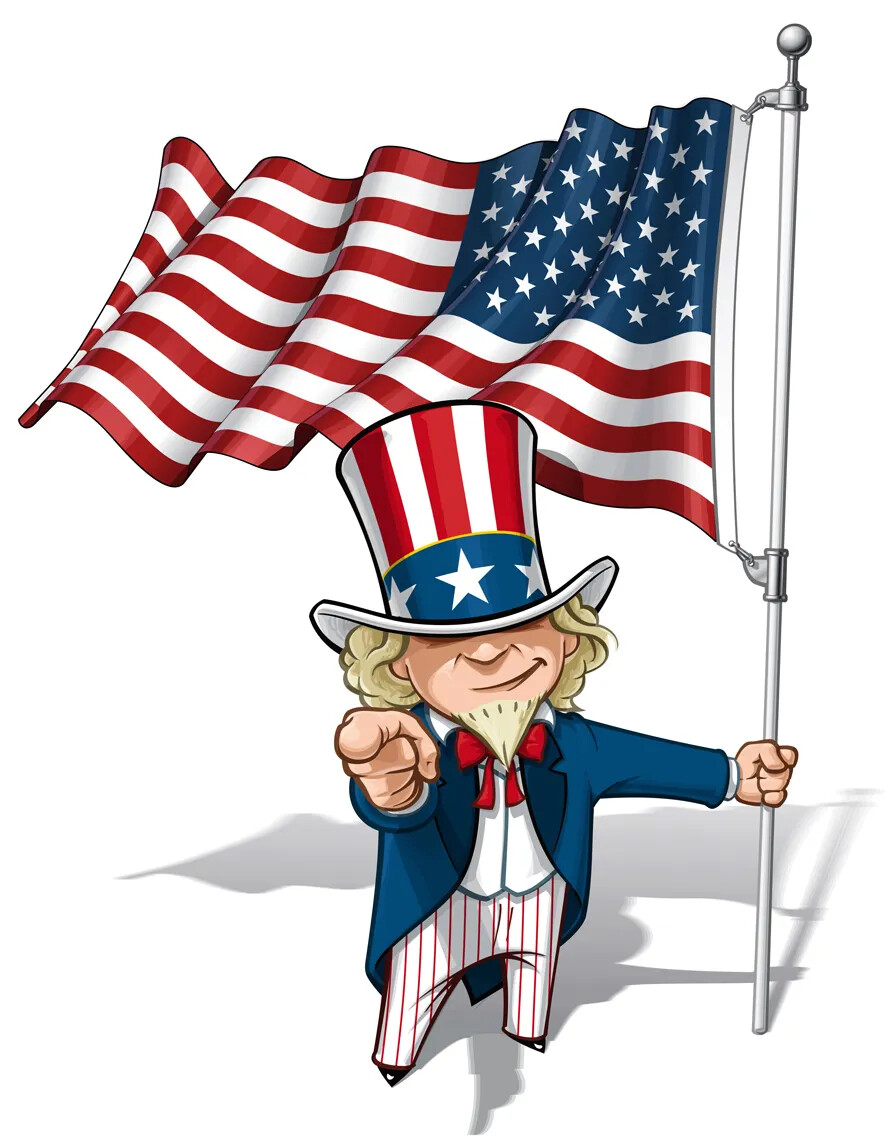
Caption:
When the United States government was created, it was different from all the other governments in the world at that time. No other country in the world was run by the people. America's political leaders decided that the American government should exist to listen to and help all of the people. The character of Uncle Sam came about in the early 1800s as a symbol of the American government.Although each state government was different, most of the men who created them shared the same ideas about the purpose of government and the foundational principles that should be the basis of good government.
The form of government they created was different from all the other governments in the world at that time. No other country in the world was run by the people. All of the other countries had rulers who only sometimes listened to the people they governed. Usually these rulers did what they thought was best, without consulting the people, and they often made decisions based on what would help them and their friends rather than everyone else.
Instead, America’s political leaders decided that government should exist to help all of the people, not just the powerful ones. This type of government was based on these five foundational principles.
1. The Social Contract
The first of these ideas was that government was based on a social contract, or an agreement between the government and the people. The people give some of their rights to the government. People agree that they are not free to do things like hurt other people or take other people’s property.
In return for the people giving up some of their rights, the government tries to protect the people from certain kinds of dangers, like an invasion from another country. The government also helps people work together to build a strong community to support each other.

Caption:
The idea of the social contract is an important foundational principle in American government. The social contract is an agreement between the government and the people. The people give some of their rights to the government. In return, the government tries to protect the people from certain kinds of dangers. The government also helps people work together to build a strong community to support each other.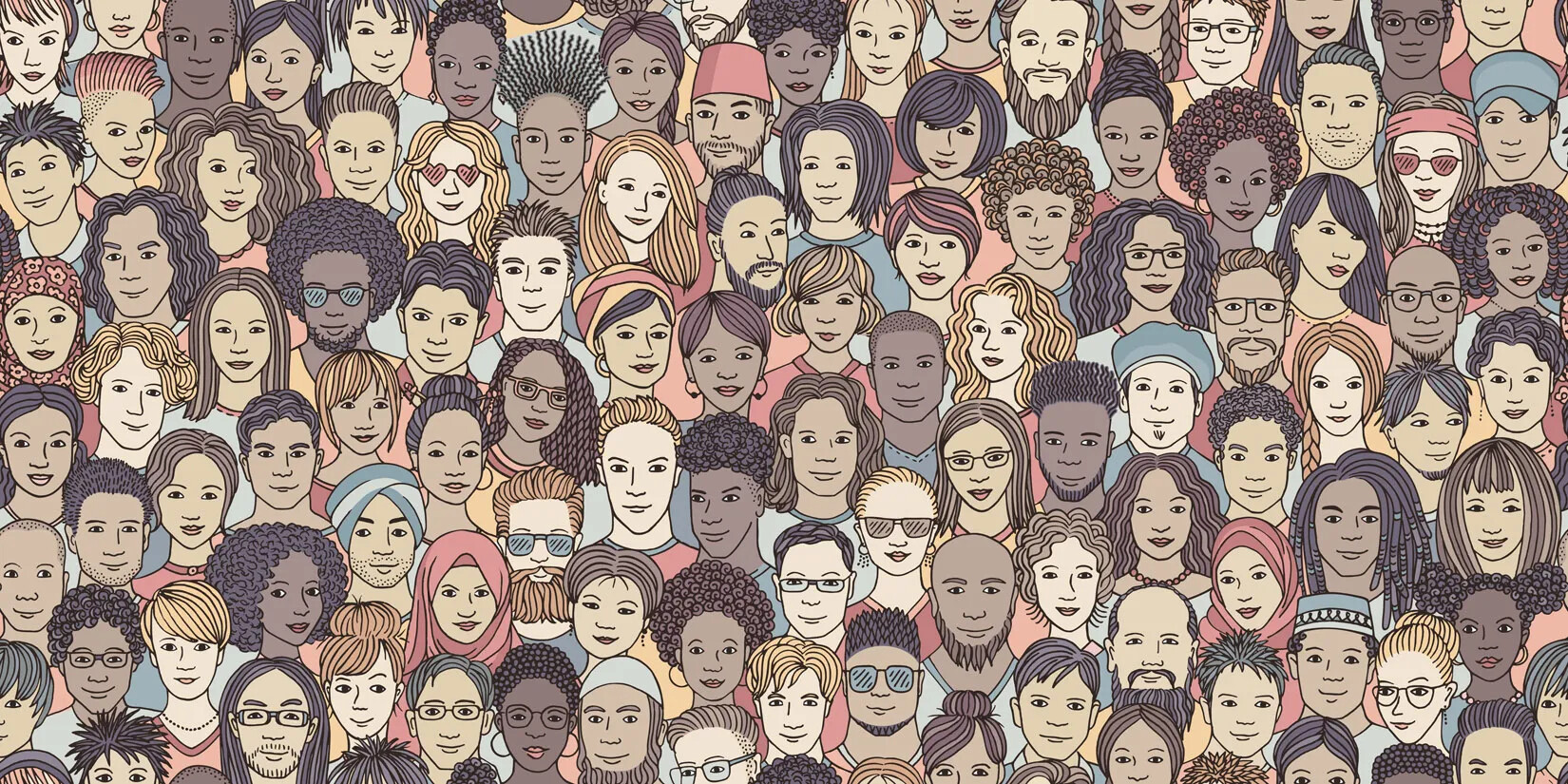
Caption:
The framers believed that the purpose of government was to benefit everyone in a society, not just a few people. They believed that the government should work for the common good. When people made decisions about what the government should do, they were also expected to consider what was best for the common good. In other words, people were supposed to think about others, not just themselves. Not everyone does that all of the time, but it is an important value or ideal that Americans should try to uphold.2. The Common Good
The men who founded American government also believed that the purpose of government was to benefit everyone in a society, not just a few people. They believed that the government should work for the common good.
When people made decisions about what the government should do, they were also expected to consider what was best for the common good. In other words, people were supposed to think about others, not just themselves.
3. Representative Democracy
How would so many people make decisions together? Americans agreed that government should be based on the idea of representative democracy. A representative democracy means that the people elect other people to represent them in the government. Representatives make decisions about what the government should do for the people who elected them.
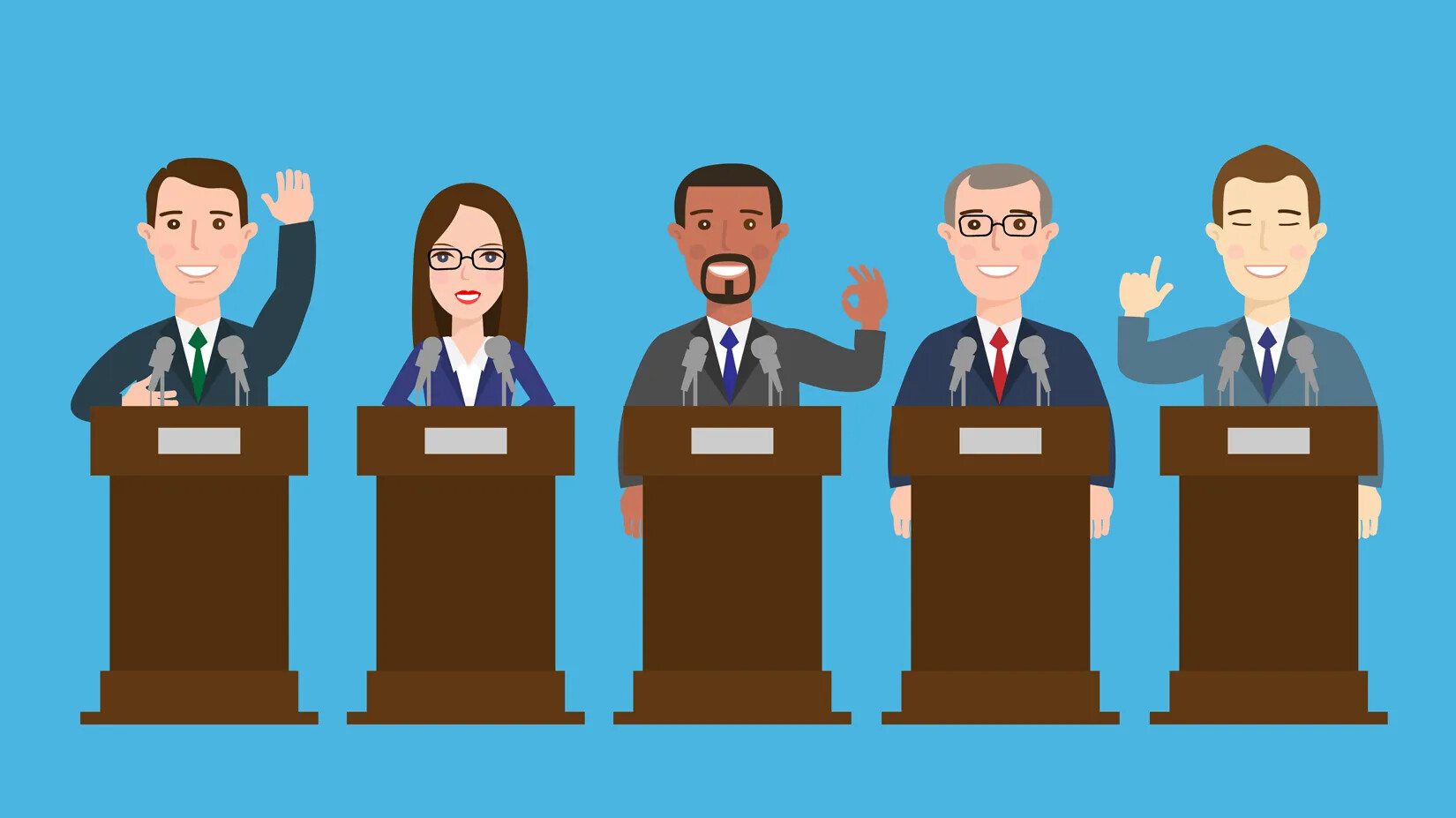
Caption:
The U.S. government is based on the idea of representative democracy. A representative democracy means that the people elect other people to represent them in the government. Representatives make decisions about what the government should do for the people who elected them. It is important to choose good representatives, and it is important for the representatives to make good decisions for the people.
Caption:
The rule of law means that everyone agrees to a set of rules and then everyone follows the rules. The most important rules of a government are written down in a document called a constitution. In America, no one is above the law, meaning that every person must follow the law. In other words, all laws apply to all of the people.4. The Rule of Law
Laws are an important part of any society. They limit what people can do so that they don’t hurt other people. Laws punish people who don’t follow the rules that the government makes. The law also protects our freedom and allows us to do the things we want to do. Laws make it possible for progress to happen because we know the law will stop other people from taking away what we build or create. The rule of law means that everyone agrees to a set of rules and then everyone follows the rules. The most important rules of a government are written down in a document called a constitution.
In America, no one is above the law, meaning that every person must follow the law. In other words, all laws apply to all of the people. Since the laws apply to everyone, we are all equally responsible for following the laws. If we don’t follow the law, then we are probably hurting someone else and not respecting their rights.
5. Limited Government
One of the most important reasons Americans rebelled against Great Britain was that Americans thought the British government was interfering with their lives too much. Instead, Americans wanted a government that would help them when they needed help but would leave them alone most of the time.
They came up with several ways to limit the power of government in America. Two ways of limiting government were particularly important.
First, they wrote down in constitutions all the things government could and could not do. Having a constitution keeps the government from growing too big and powerful. Everyone knows what the government’s powers are because they are written down for everyone to see.
Second, the government’s power was split into different levels: the national government, state governments, and local governments. This division of government power is called federalism. If the government is divided this way no part of the government grows too big because each level of government can only govern in its own area. This means that federalism limits the power of the government.
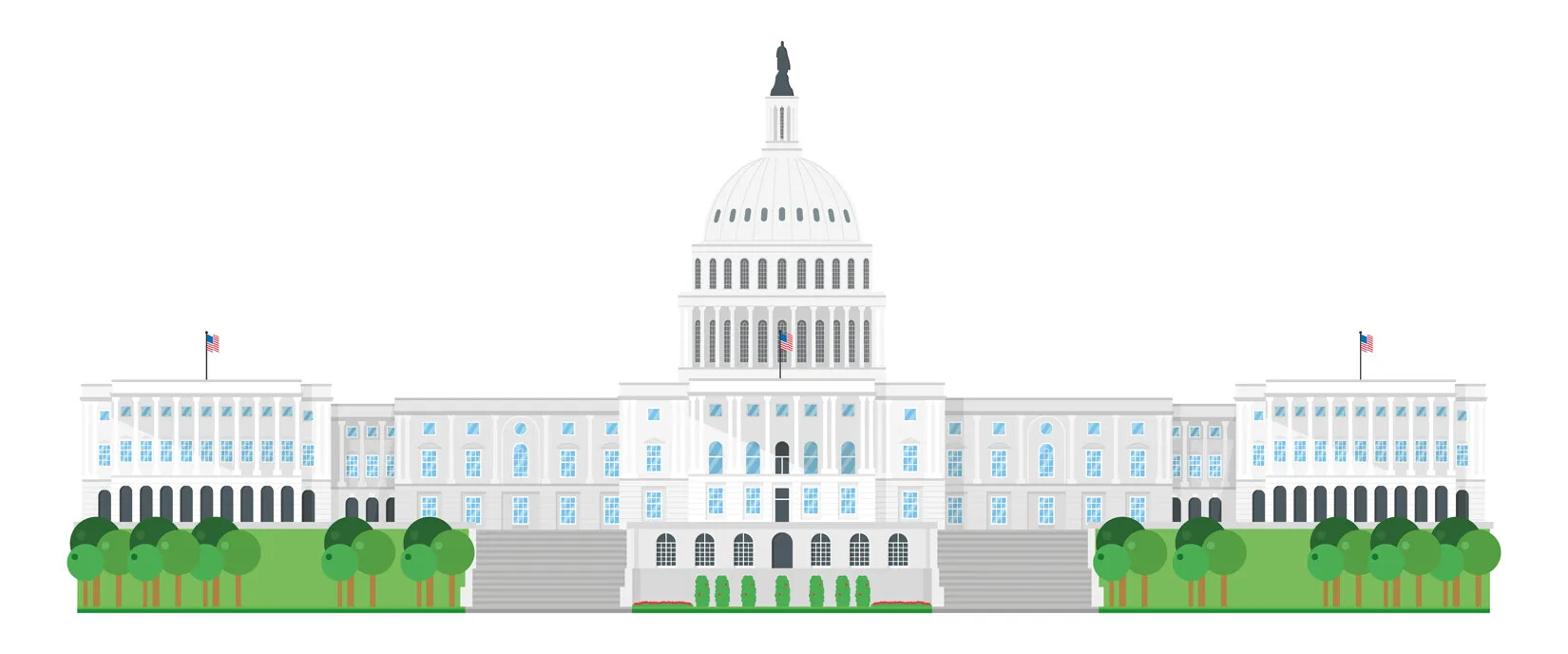
Caption:
The Capitol building in Washington, D.C., is where the U.S. Congress meets. The U.S. Congress is part of the national government. It is the legislative branch of the national government. In the United States, the government's power is split into different levels: the national government, state governments, and local governments. This division of government power is called federalism. Federalism helps limit the power of the government.As each colony became a state, the political leaders in each state wrote a constitution and created a state government. Although each state government was a little bit different from the others, they were all founded on these five fundamental ideas. When the 13 states came together to form a government for the whole country, the national government was also based on these five ideas.
For more about the foundations of American government and how it works in our own time, go to Unit 18: Civics and Government Today.
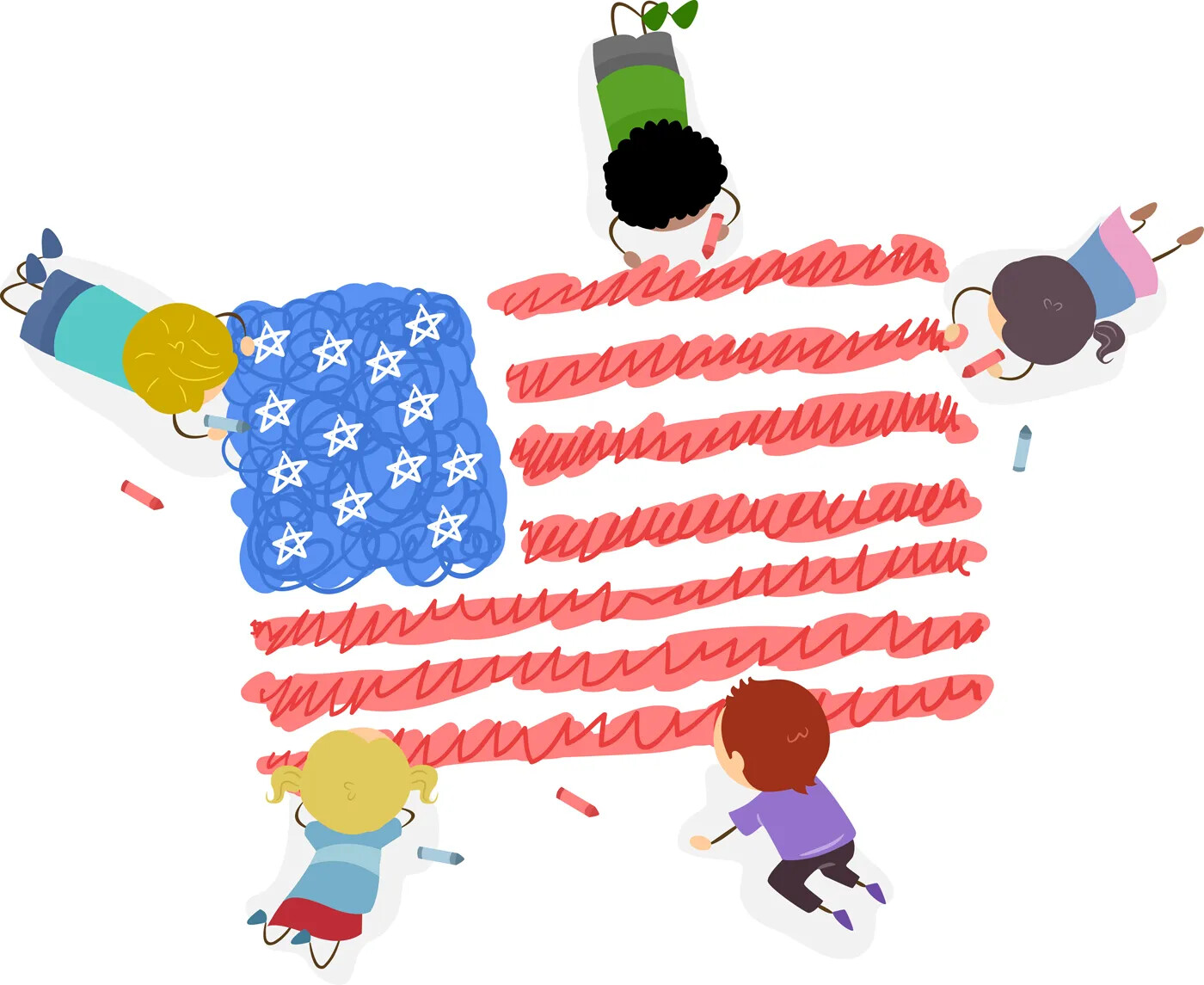
Caption:
The United States started out with just 13 states, from the 13 original British colonies. Vermont joined the United States in 1791, and over the next 170 years, 36 more states joined the union. Each state government is a little bit different, but they are all founded on five foundational principles: the social contract, the common good, representative democracy, the rule of law, and limited government. The national government is based on these principles as well.Let's Review!
What are the big ideas in this section?
A New Government
During the American Revolution, states formed new governments for themselves, and then when the war ended, the Founding Fathers came together to make a national government. These governments were the first of their kind because they were run by the people and existed to help all of the people.
Five Ideas
The governments were all based on five ideas that were central to their creation. Although each state government was different, the men who created the state governments and the federal government all shared these ideas about the purpose and limits of government.
Society Working Together
First, in a social contract, the people give up some rights to the government. Then, the government supports the community and protects the people. Second, everyone agrees that benefiting the common good, or the good of the community, is the purpose of government. Third, people elect others to make decisions for them in the government, creating a representative democracy.
Limits on Power
Fourth, the rule of law means that everyone agrees to a set of public rules and everyone follows these rules equally. Fifth, limited government means that the people need the government but don’t want it to have too much power. They wrote constitutions to say what governments can and can’t do. They also split up the governments’ powers between federal, state, and local governments, which is called federalism.
N.H. State Constitution
What is a constitution?
A constitution is a written document that explains the social contract the people have made with the government. It states what the government can and cannot do. Constitutions also limit the power of government because the government’s powers are written down for everyone to see. If the government tries to do more than it is allowed to do, the people can point to the constitution to show that the government is trying to expand its power. In this way, constitutions also protect people’s rights because they often include a list of exactly what the people’s rights are.

Caption:
A constitution is a written document that explains the social contract the people have made with the government. It states what the government can and cannot do. Constitutions also limit the power of government because the government’s powers are written down for everyone to see.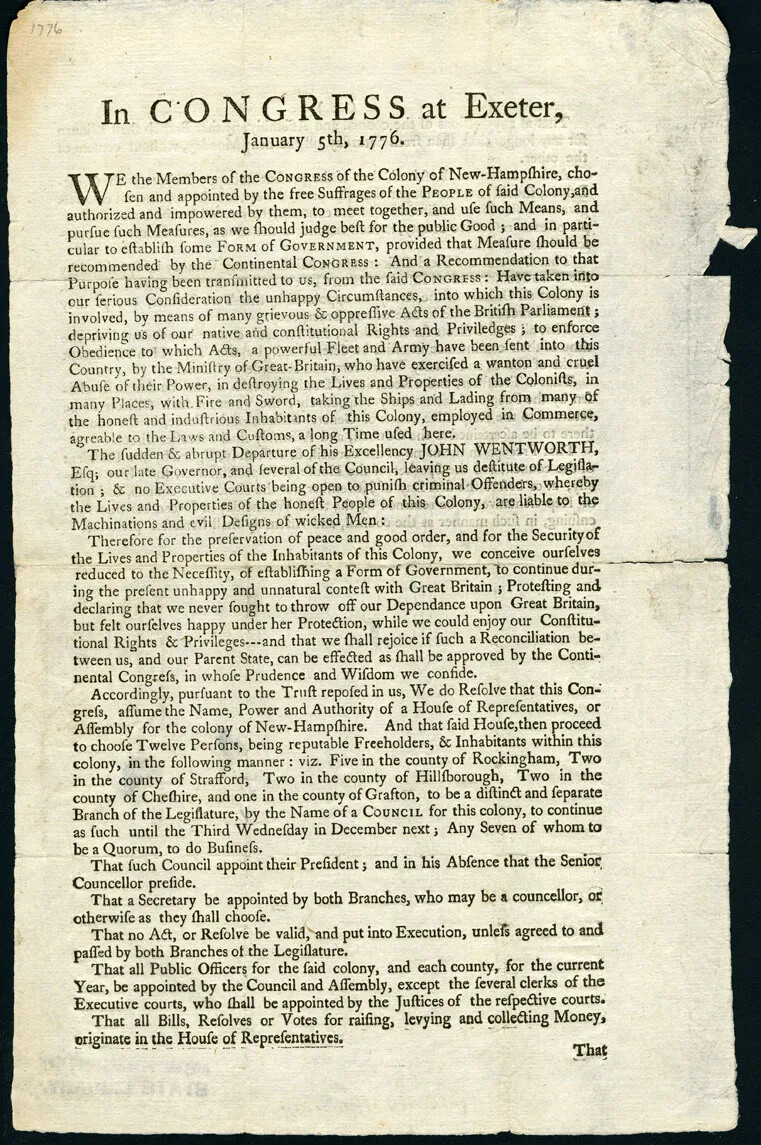
Caption:
After war broke out between England and the American colonies, New Hampshire was the first of the 13 colonies to establish an independent government. Their governor, John Wentworth, had left the colony because the people did not support him. First the people elected a new government, called the Provincial Congress. The Provincial Congress decided to write down the rules of their new government in a document called a constitution. This was the first written constitution, not just in the American colonies, but in the whole world! It was intended to be temporary until the Revolutionary War ended. All of this happened six months before the Declaration of Independence was written!Caption:
On January 4, 1776, New Hampshire became the first British colony to declare its independence from Great Britain. Since New Hampshire was now an independent state, its leaders wrote a new constitution for it, which laid out how the government would function. New Hampshire, therefore, formed the first state government in America.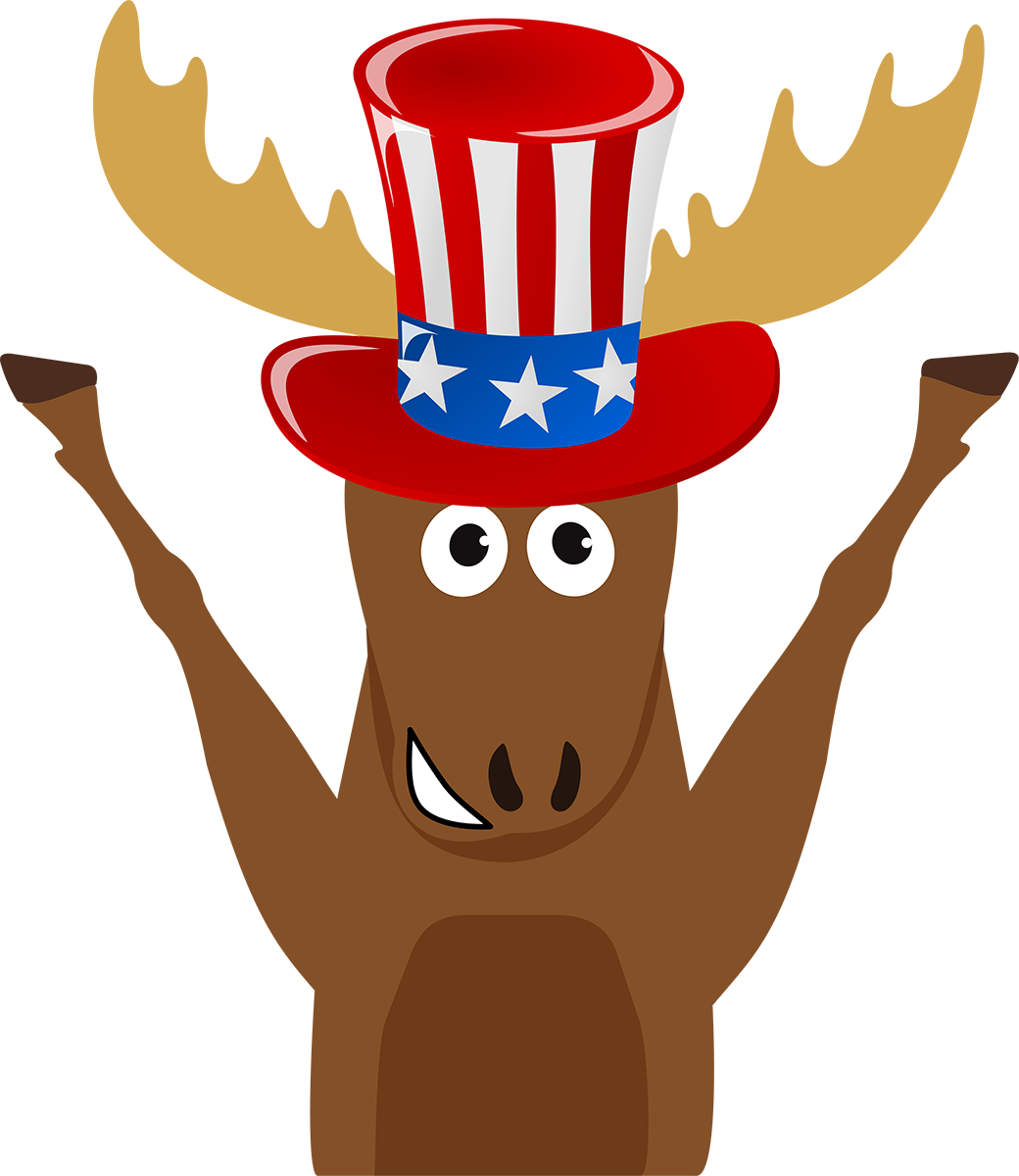
New Hampshire becomes a state! On September 11, 1776, the New Hampshire government voted to stop calling New Hampshire a colony and start calling it a state. Before then, New Hampshire had been a colony of Great Britain, but after many years of arguing about the way Great Britain governed New Hampshire, the people of the colony declared their independence by setting up a new government. The other American colonies did the same thing. The colonies’ fight to throw off British rule and become their own country was called the American Revolution.
How did New Hampshire write a constitution and create a state government?
New Hampshire was the first of the 13 colonies to write a constitution. But this constitution, which was adopted in January 1776, was only supposed to be in place during the Revolutionary War. It was a temporary constitution, and it created a temporary government. Even before the war ended, the people of New Hampshire started asking for a new constitution to create a more permanent state government.
Writing a new constitution for New Hampshire and creating a state government wasn’t an easy job. The people of New Hampshire all had different ideas about government.
- How should the government be organized?
- Was it better to have a government that tried to fixed their problems or that left them alone to handle their problems themselves?
- What rights were people giving up to the government, and what rights would be theirs no matter what?
- Who should get a vote? How often should people vote and on what kinds of things?
- Could they change a form of government that wasn’t working well? How?
There were lots and lots of things to decide so New Hampshire’s political leaders decided to hold a big meeting to debate these questions and write a constitution. This meeting was called a constitutional convention, and New Hampshire held the first constitutional convention ever. It was held in Exeter in 1778. Each town elected delegates, who were usually the most respected men of the community, to represent them at the constitutional convention.
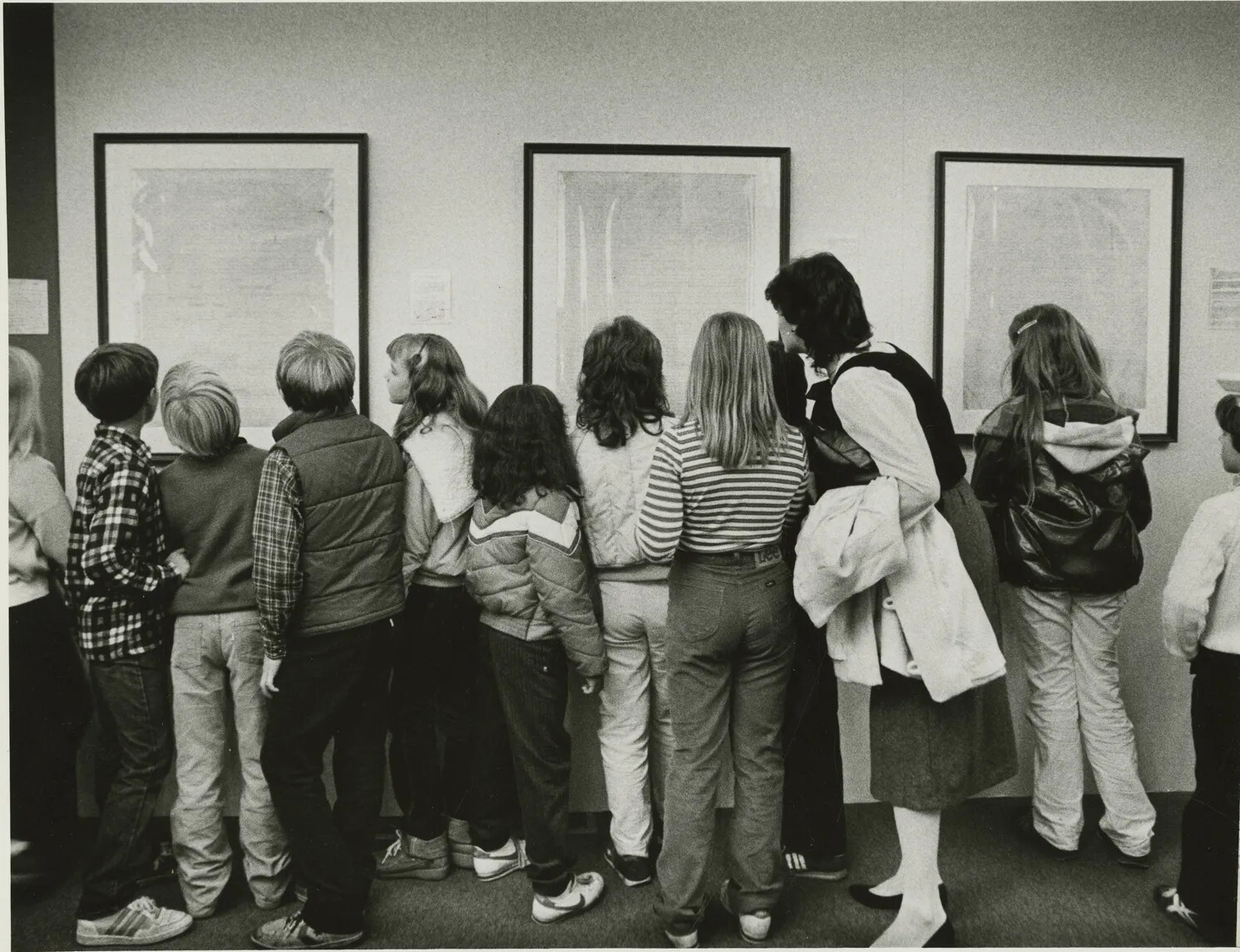
Caption:
In 1983, to get ready for the 200th anniversary of the N.H. Constitution, the original document was put on display at the State House. These 4th graders from Windham, New Hampshire, got the chance to view it in person.It took a long time and a lot of discussion for the constitutional convention to resolve many of these issues. The delegates elected Meshech Weare president of the constitutional convention. He was already running New Hampshire’s government, so he was an obvious choice, and almost all of the delegates agreed that he should lead them in creating a new state constitution.
But the delegates didn’t agree on much else. Not much gets done when people don’t agree on things, so the delegates had to talk to one another and try to build a consensus. They also had to compromise with one another. In this way, they slowly started writing a constitution that had the support of a majority of the representatives, including some of the most important political leaders in the state, like John Sullivan, John Langdon, Josiah Bartlett, and William Whipple.
Caption:
Meshech Weare was New Hampshire’s first governor. He is also sometimes called the “father of New Hampshire” because he played such an important role in creating the state government. When New Hampshire was an English colony, he represented the town of Hampton Falls in the colonial assembly. He supported American independence from the British Empire and helped write the N.H. Constitution of 1776 that declared New Hampshire’s independence from Great Britain. During the American Revolution, Weare was chief justice of New Hampshire’s highest court and the head of the Committee of Safety, which governed the state during the war. After the N.H. Constitution of 1784 was ratified, Weare was elected the first governor, which was then called “president.” The town of Weare is named after him.Caption:
John Sullivan was a well-known general from New Hampshire during the American Revolution. After America won its independence, Sullivan became an important political figure in New Hampshire. In fact, he helped convince the people of New Hampshire to ratify the U.S. Constitution in 1788. Sullivan was born in Somersworth and became a lawyer when he was a young man. When Americans grew unhappy with being ruled by Great Britain, Sullivan supported the patriots. He even led the raid on Fort William and Mary in 1774, when patriots took control of a British fort in Portsmouth. When America and Britain began fighting the American Revolution, Sullivan became a general in the American army. After the American Revolution was over, he became one of New Hampshire’s first governors. When the people of New Hampshire were deciding whether or not to support the new U.S. Constitution, Sullivan used all his influence to convince them that the Constitution created a good system of government for the new country.Caption:
John Langdon was an American Founding Father and an important political leader from New Hampshire. He was an early supporter of independence from Great Britain. He served in the Continental Congress and led troops at an important American victory, the Battle of Saratoga. After the American Revolution, he was the second person to be elected governor of New Hampshire , which was then called “president.” Langdon was one of New Hampshire’s delegates to the Constitutional Convention in 1787. He supported a strong central government and campaigned in favor of ratification in New Hampshire. His efforts helped New Hampshire become the ninth and deciding state to ratify the U.S. Constitution. He was one of New Hampshire’s first U.S. senators, serving from 1789 to 1801. Later he was elected to the New Hampshire House of Representatives and again as New Hampshire’s governor.Caption:
Josiah Bartlett was one of the three signers of the Declaration of Independence from New Hampshire. He was a doctor who lived in Kingston. Bartlett was a patriot and held secret meetings with other patriots in his attic. His house was even burned down once by people who opposed the patriots. He was on the N.H. Committee of Correspondence and was chosen to be in the Continental Congress. He was the second person to sign the Declaration of Independence. After the war, Bartlett continued to work as a doctor and even served as governor of New Hampshire at one point.Caption:
William Whipple was one of the three signers of the Declaration of Independence from New Hampshire. His father was a sea captain, and as a young man, Whipple went to sea as well, sailing back and forth between the Caribbean and New England, shipping wood, rum, and slaves. Later, he and his brother were successful merchants in Portsmouth. Whipple supported the patriots and was in the Continental Congress. He signed the Declaration of Independence in 1776. He was also a general in the New Hampshire militia and commanded troops at an important Revolutionary War battle, the Battle of Saratoga. After the war, he freed his slaves, including Prince Whipple. He also served in the New Hampshire legislature and on the Supreme Court of New Hampshire.Once the delegates wrote a constitution that most of them agreed on, they shared the constitution with the people of New Hampshire to see what they thought. Unfortunately, the people didn’t like the first constitution the delegates produced. So, the delegates listened to what the people said, made changes to the constitution, and wrote another draft. And the people still didn’t like it! This went on for five years, with the delegates writing new drafts and the people rejecting them.
Finally, in 1783, the people of New Hampshire liked the constitution and voted to adopt it. The constitution went into effect in 1784. Although parts of the 1784 state constitution have been changed over the years, it is still the same constitution New Hampshire has today. In fact, it is the second oldest constitution in the United States. Only Massachusetts’ constitution is older.
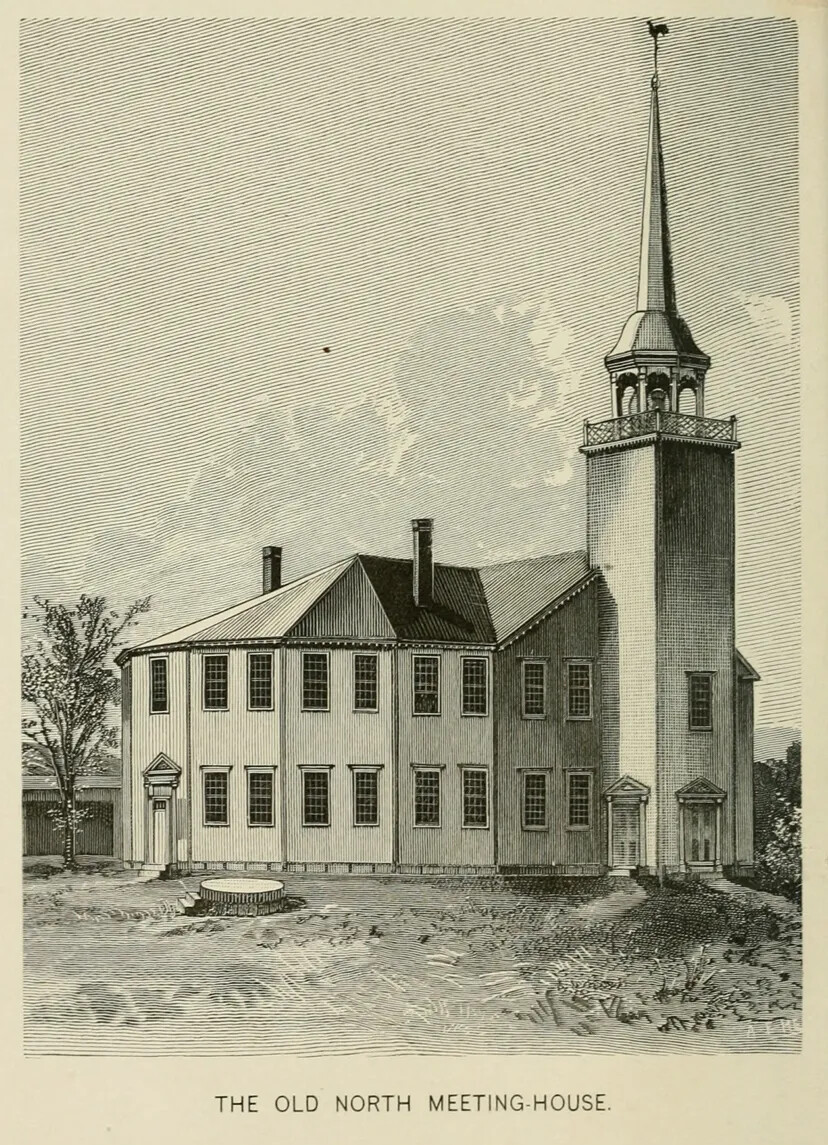
Caption:
The N.H. Constitution was ratified in 1783, and went into effect in 1784. The new legislature began meeting in June of 1784. They met at the North Meeting House in Concord, NH. A few years later, in 1788, New Hampshire's federal constitutional convention met in the same building to ratify the U.S. Constitution.
A New Hampshire Rebellion! Not everyone in New Hampshire was sure they wanted to be part of this new state. In fact, most of the people who lived in the Connecticut River Valley decided that their towns would become part of Vermont! Because these towns were in the western part of the state, this episode is called the Western Rebellion. Between 1777 and 1783, 38 towns in the western part of New Hampshire insisted that they were actually part of Vermont. The New Hampshire state government even sent soldiers to some of the towns to keep law and order because there was so much confusion about who was in charge. When the new constitution was adopted, though, those 38 towns rejoined New Hampshire, and the Western Rebellion was over.
What is in the New Hampshire Constitution of 1784?
The New Hampshire Constitution of 1784 begins with a preamble that explains why we have a state government. It reads:
“All men are born equally free and independent; therefore, all government of right originates from the people, is founded in consent, and instituted for the general good.”
There are a lot of ideas packed into that one sentence! What does it all mean? The preamble lays out four big ideas on which government in New Hampshire is based:
- The first idea—“All men are born equally free and independent”—is stated clearly. We are all equal in the eyes of the government and the law.
- The second idea—“all government of right originates from the people”—states that New Hampshire’s government would be run by the people themselves, not by a king or a dictator.
- The third idea—“founded in consent”—refers to the social contract that people form with the government. We give up some of our rights, and in exchange the government helps and protects us.
- And the fourth idea—“instituted for the general good”—reminds us why we have government in the first place: for the common good of all of society.
The N.H. Constitution is divided into two main parts: a bill of rights(Part 1) and the form of government (Part 2).
N.H. Bill of Rights
In 1784, the N.H. Bill of Rights listed 38 rights that belonged to the people. The government cannot make laws that take away these rights. The people have rights that remain in their control. The government is not allowed to infringe on those rights.
However, the government is responsible for protecting everyone in a society, so it can limit people’s rights to protect other people’s rights.
Believing in the common good means recognizing that everyone else’s rights are just as important as your own. For example, you may have a right to swing your arm, but you don’t have the right to swing your arm so far that it hits somebody else. The laws that the government makes help people remember that their rights have limits and that other people have rights too.
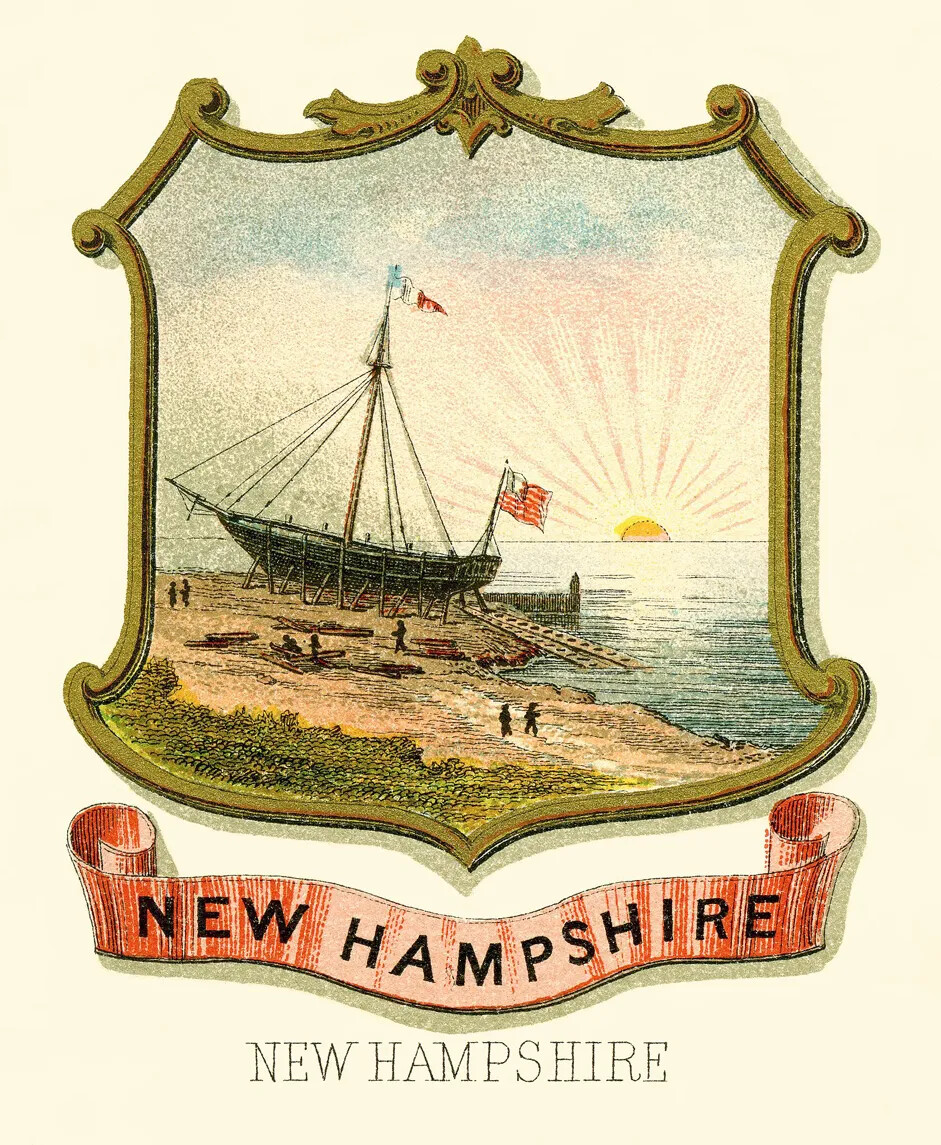
Caption:
A coat of arms is a visual symbol used to identify an individual, family, state, or organization. New Hampshire's coat of arms is similar to its state seal, but not quite the same. They both have a ship, because Portsmouth has always been an important shipbuilding center. They both show a harbor and a rising sun. The coat of arms also shows people.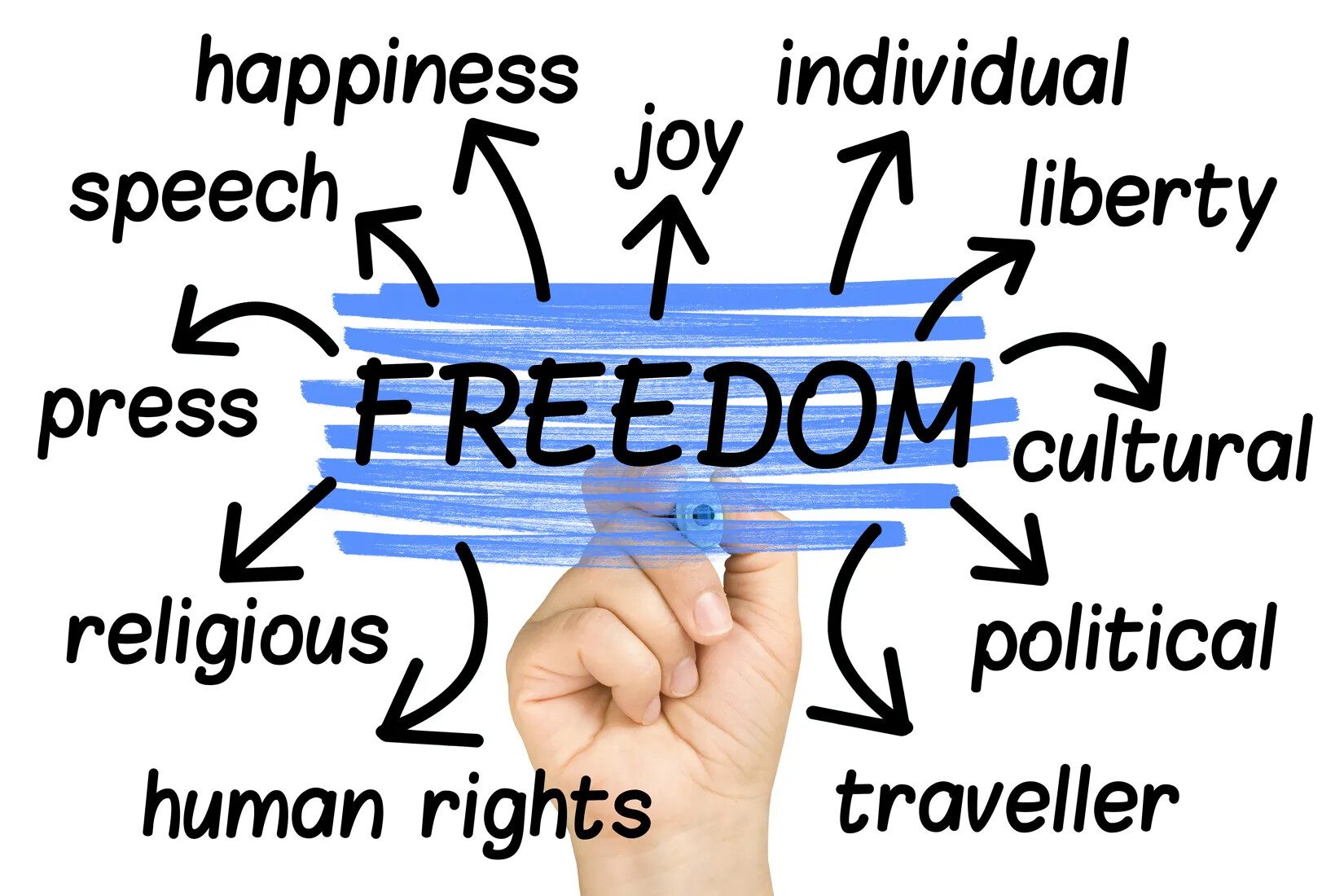
Caption:
The N.H. Constitution begins with a list of rights that belong to the people. Some of those rights include important freedoms, like freedom of the press, the freedom to speak freely, the freedom to meet in groups, and the freedom to believe what we want. All of the other states' constitutions also have a bill of rights. The U.S. Constitution has a Bill of Rights, too, which is the first 10 amendments.
There was one right listed in the N.H. Constitution that did not appear in other state constitutions of the time. It was the right of rebellion, which is Article 10. It says that the purpose of government is to promote the common good, and if the government doesn’t do that, then the people have the right to rebel against it and create a new government. Other states implied this right in their constitutions. After all, it is part of the social contract between the government and the people. But the people of New Hampshire wanted this right to be written openly in their state constitution.
Although the 38 rights listed in the N.H. Constitution cover a lot of different topics, they can be grouped into a few categories:
- Protections for people who have been accused or convicted of a crime to make sure they are treated fairly
- Limits on the power of New Hampshire’s government
- Reminders of the importance of a free press, meaning the government can’t control what journalists write and publish
- Freedoms that are guaranteed to all people who live in New Hampshire, like the freedom to speak freely, to think and believe what we want, and to meet together in groups
All of the state constitutions written after the American Revolution included a bill of rights that are like the one in the N.H. Constitution. Americans had just fought a war against Great Britain because they thought the British government didn’t respect their rights. They wanted to make sure that the new governments they created always remembered and protected these rights because these rights were very important to them. As long as the people had these rights, they knew they had their liberty.
The N.H. Constitution has been changed many times since 1784, and the list of the people’s rights has gotten longer. There are now 87 rights listed in the N.H. Constitution!
N.H. Form of Government
The N.H. Constitution divided the state government into three branches:
- Executive Branch: the governor, the executive council, and all of the state offices
- Legislative Branch: the state legislature, which is called the General Court. The legislature is split between the N.H. House of Representatives and the N.H. Senate
- Judicial Branch: the court system
Each branch has specific powers that the other branches don’t have. Also, each branch can check the other branches, which keeps any one branch from becoming too powerful. Most of the people who hold offices in the state government are elected by the people, and many of them can be voted out of office if the people don’t like what they do while in office. All three branches work for the common good of the people of New Hampshire.
More information about the division of power between these three branches of government and the way each branch works is in Unit 18: Civics and Government Today.
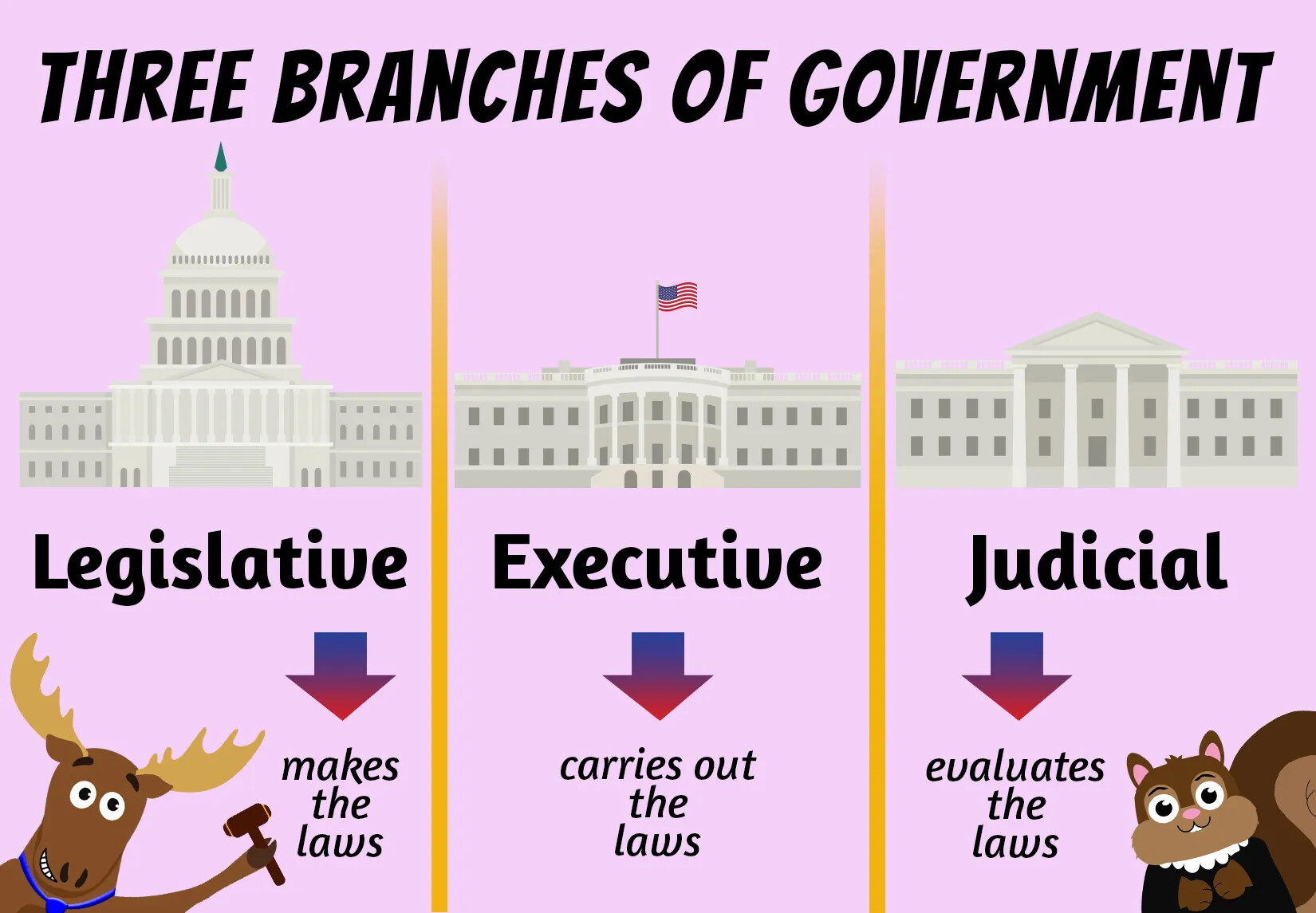
Caption:
State governments and the national government are divided into three branches: the executive, legislative, and judicial branches. Each branch has specific powers and responsibilities that the other branches do not have. Each branch can also check the other branches, which keeps any one branch from becoming too powerful. All three branches are supposed to work for the common good of the people.
When the N.H. Constitution was written in 1784, the governor of the state wasn’t called the governor. He was called the president of New Hampshire. And when people spoke to him, they didn’t call him “Mr. President.” Instead, they called him “Your Excellency.” In 1793, the people of New Hampshire decided that it was too confusing to have a president of New Hampshire and a president of the United States, so they changed the name of the office to governor.
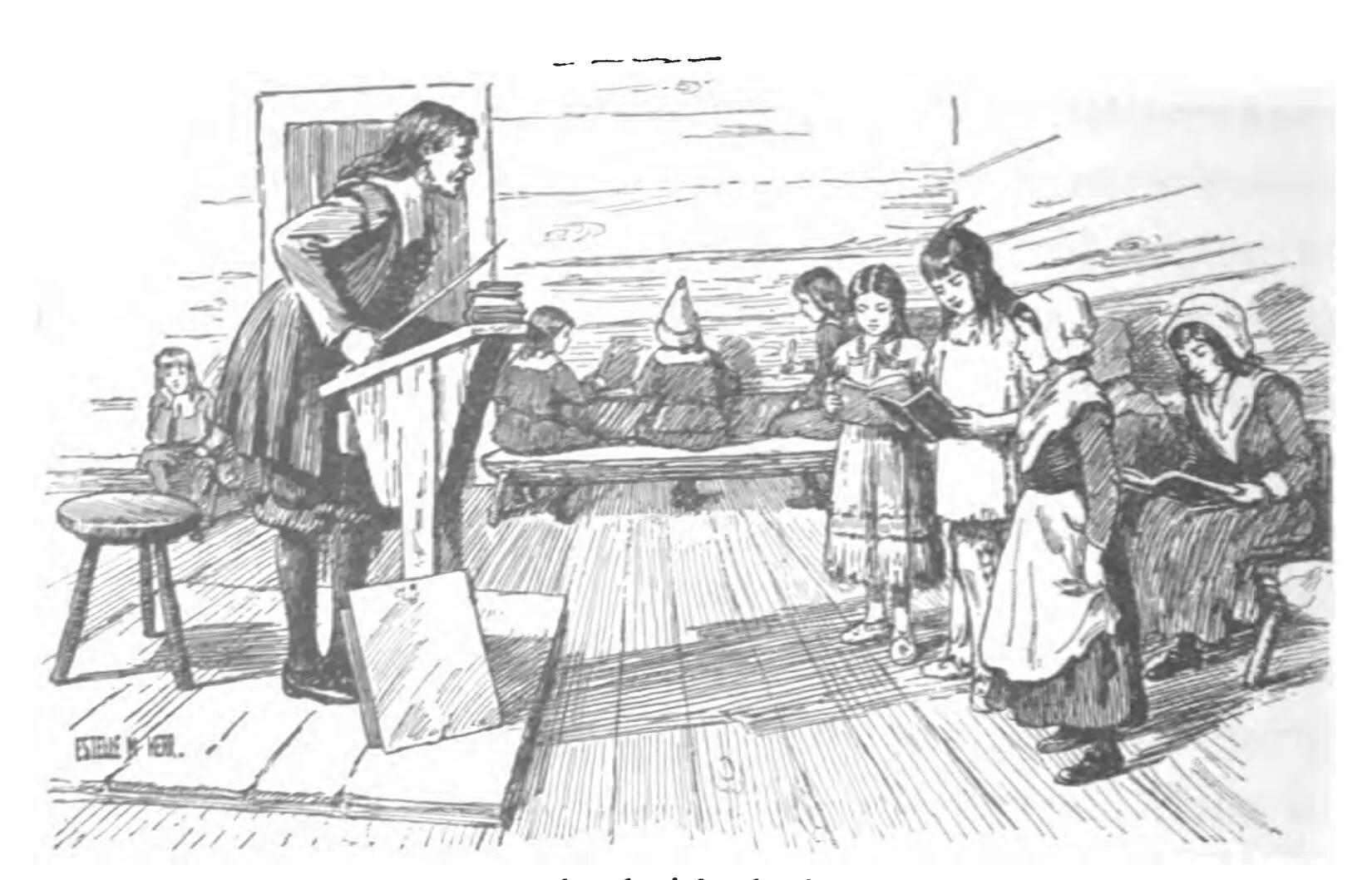
Caption:
New Hampshire communities established schools for children starting in the 1640s. It was important to the settlers that children learn to read, write, and do simple math. Children did not attend school every day because they usually had a lot of chores to do on the farms.The N.H. Constitution also includes a section that discusses the importance of education in a free society. The people must know how their government works when they are responsible for making decisions about what the government will do.
The N.H. Constitution supports education as a way to teach people about civic virtues that are important for a democratic government, things like honesty, kindness, charity, and hard work. A democracy that is run by the people requires each of us to play an important role in supporting our government and respecting each other’s rights. If each of us practices these civic virtues, then the government won’t have to step in to protect people’s rights as often.
The N.H. Constitution of 1784 also said that every seven years, the people of New Hampshire got to vote on whether they want to hold a new constitutional convention and make changes to the constitution.
By making the government check in with the people on a regular basis, the writers of the N.H. Constitution hoped that the constitution could be kept up-to-date with the changing times and they could fix anything in the constitution that wasn’t working right.
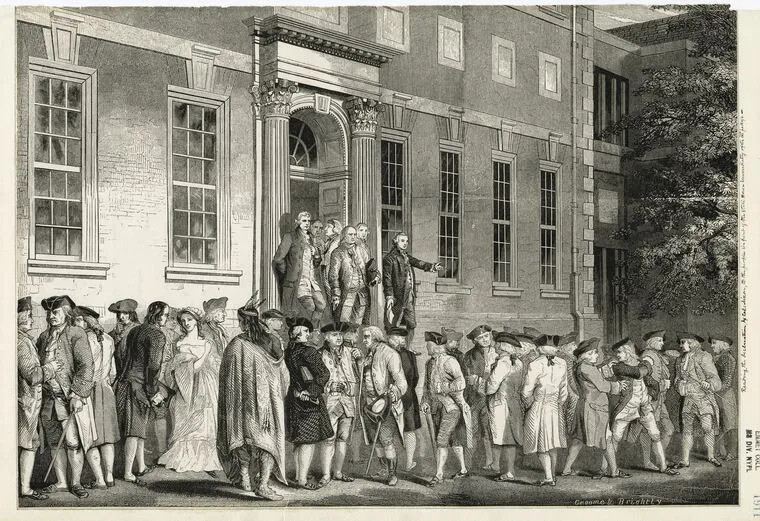
Caption:
Starting with the Declaration of Independence in 1776, one of the important ideas of American government is that it needs to represent the people and be responsive to the people. This was long before television and cell phones, and not everyone could read. So people had to get their news of the government from hearing it read aloud. Crowds gathered at meeting houses, city halls, and other public buildings to hear important documents read aloud. In this picture, someone is reading the Declaration of Independence out loud to a crowd just after it was passed. Other important documents, like the N.H. Constitution, were read to the people too. That way the people could decide whether they supported it or not.
In 1791, New Hampshire held another constitutional convention and made a lot of changes to the 1784 constitution. But after that, there were no changes at all to the N.H. Constitution for almost 60 years. Since 1850, though, there have been nearly 200 changes to the N.H. Constitution!
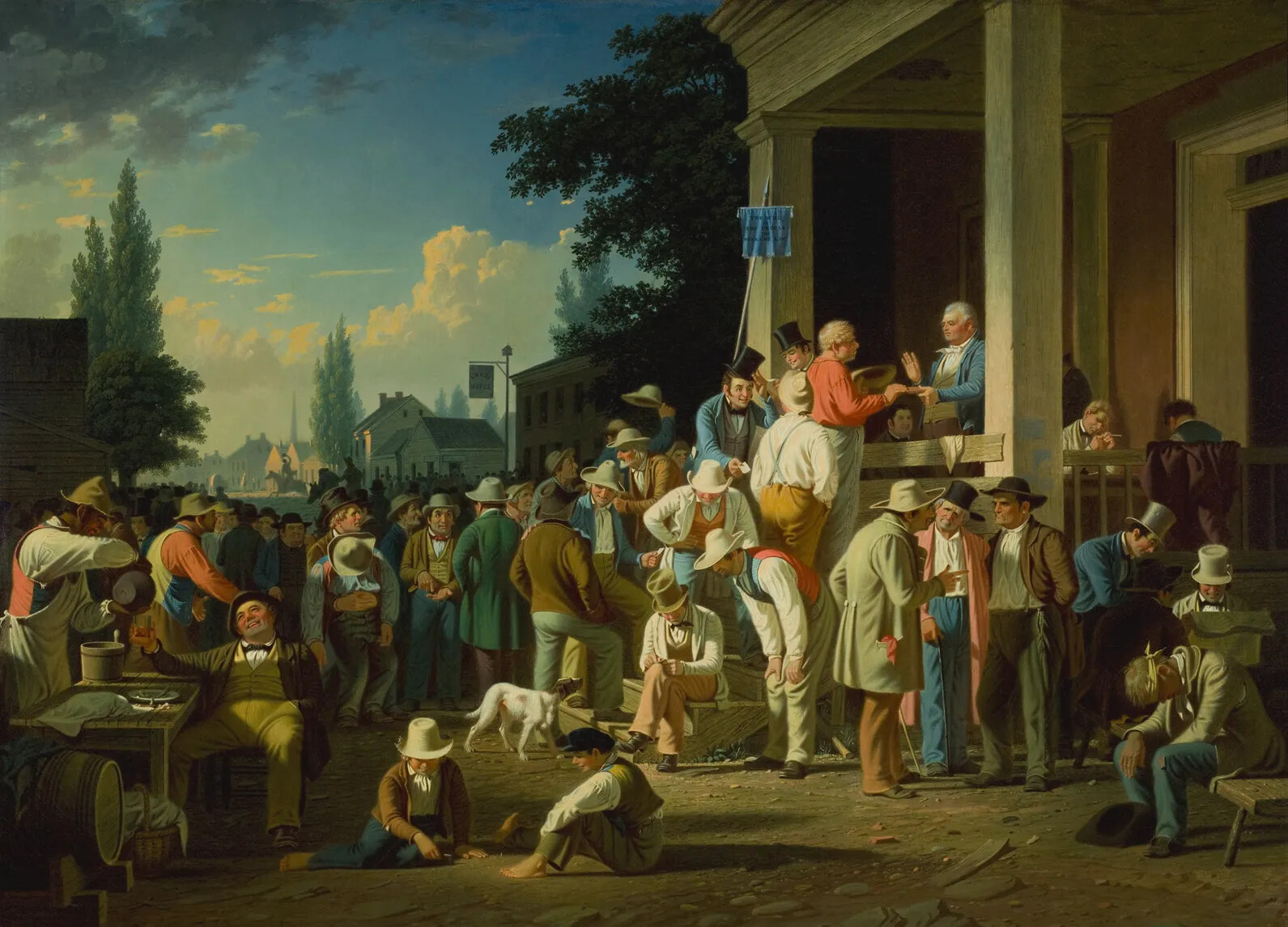
Caption:
Voting is a very important civic virtue. But at the time that the N.H. Constitution and U.S. Constitution were written, voting rights were limited. Only white men could vote, and in many places, only white men who owned property could vote. Women, people of color, and indigenous people could not vote. This was still true 75 years later, when this painting of an election was made.Who got to vote under the N.H. Constitution of 1784?
At this time in American history, voting was usually allowed just for white men who had a lot of money. The N.H. Constitution allowed more white men to vote than other states did because in New Hampshire white men did not need to own a certain amount of property to vote. They only needed to pay taxes.
But lots of people were not allowed to vote at all in New Hampshire, including women, who were half of the population. Even if a woman owned property and paid taxes, she was not allowed to vote in New Hampshire, or any other state, at this time. Women would not be able to vote in the state for over 100 more years.
Men who were not white were not allowed to vote either in New Hampshire or the other states. So an African American or Native American man could not vote even if he owned property and paid taxes. These laws did not change for nearly 100 years either.
Let's Review!
What are the big ideas in this section?
The First State Constitution
A constitution is a written document explaining the powers of the government, how it is limited, and the rights of the people. NH wrote the first state constitution in 1776 during the American Revolution. But in 1778, the people wanted a constitution for peacetime, so delegates went to Exeter to decide on a new constitution.
Building a Consensus
After many drafts and discussions, New Hampshire’s second constitution went into effect in 1784. It is the same constitution New Hampshire has today. It is divided into two parts: a Bill of Rights (Part I) and the Form of Government (Part 2).
N.H. Government
The Bill of Rights in the 1784 constitution lists 38 rights that belong to the people. The people’s rights are protected, but the government can limit people’s rights to protect the common good. The government is divided into three branches: the executive, the legislative, and the judicial. These parts all have powers and keep watch on each other so they use their power well.
Other Important Ideas
The N.H. Constitution included the importance of education to teach people about civic virtues. In addition, New Hampshire’s people have a chance to change the constitution every seven years. It’s also important to know that in 1784, only white men who owned property could vote in New Hampshire.
The Path to the U.S. Constitution
Why do we need a national government?
Each state wrote its own constitution and created its own government after the American Revolution, but the United States also needed a national government that would govern the entire country.
A national government that would serve all 13 states needed to do several things:
- It needed to provide defense for the United States so that the country wasn’t taken over by another country.
- It needed to settle arguments or disagreements between the states.
- It needed to encourage trade and business between the states.
- It needed to encourage trade and business between the United States and other countries.
- It needed to make sure that the state governments were not infringing on the rights that were guaranteed to all Americans.
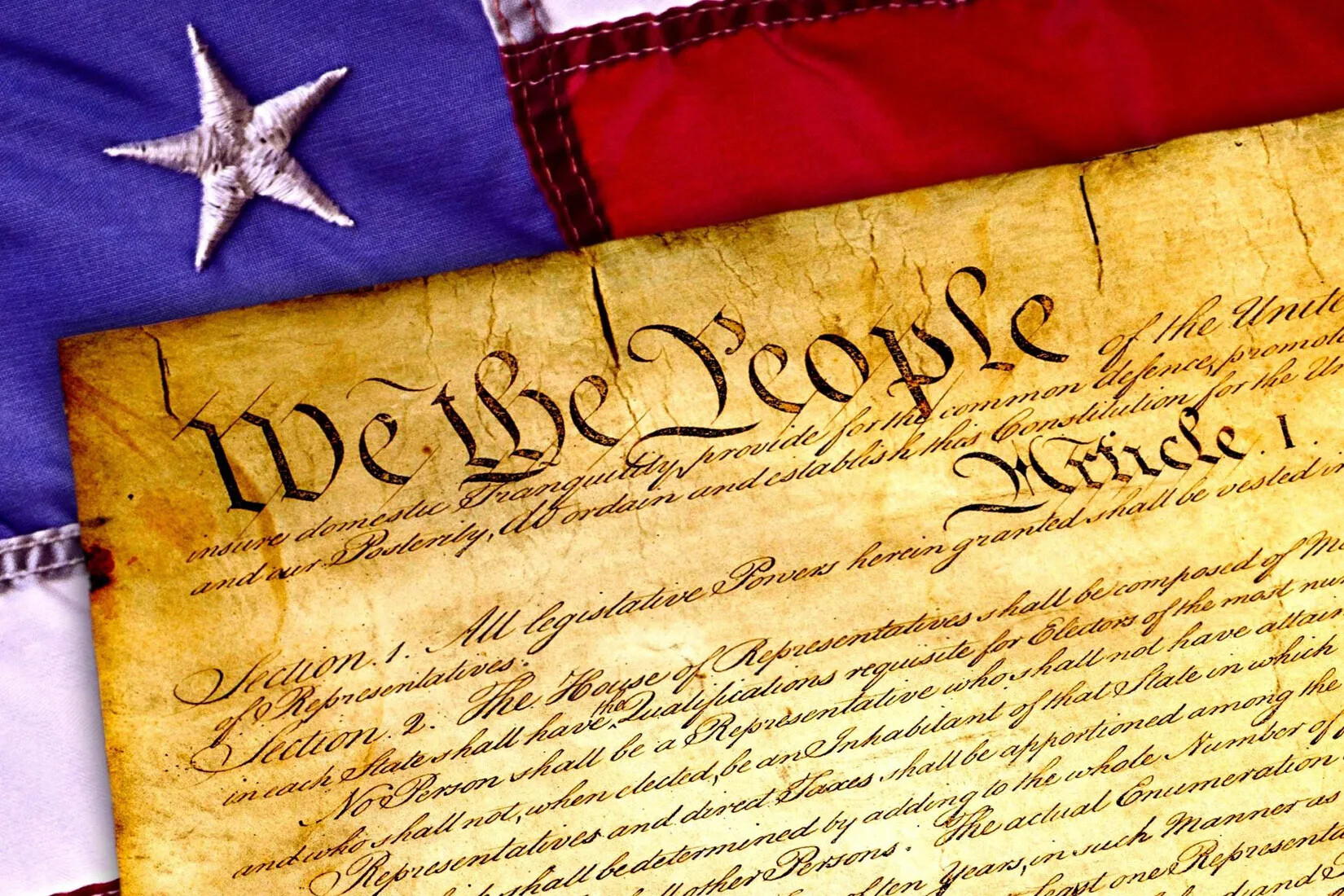
Caption:
After winning independence from Great Britain, the 13 new states each formed their own state governments with written constitutions. But they needed a national government, too.A national government was also a way to promote the ideas and values that all Americans shared, such as the beliefs expressed in the foundational principles. Americans, no matter what state they lived in, believed in these ideas:
- There is a social contract between the government and the people.
- Government is created to promote the common good.
- The people democratically elect representatives to make decisions about the government for them.
- Everyone has an equal responsibility to follow the laws.
- The power of government must be limited by dividing it between several levels in a system of federalism.
Just as these ideas are at the basis of state government, they are also at the basis of the national government.
Americans were committed to the ideas listed in the Declaration of Independence—that the United States should treat all men equally and allow them as much freedom as possible. This is what the Declaration of Independence meant when it said that we are all entitled to “life, liberty, and the pursuit of happiness.”
Our country hasn’t always practiced these ideas as well as it could, but Americans believe we should always keep trying.
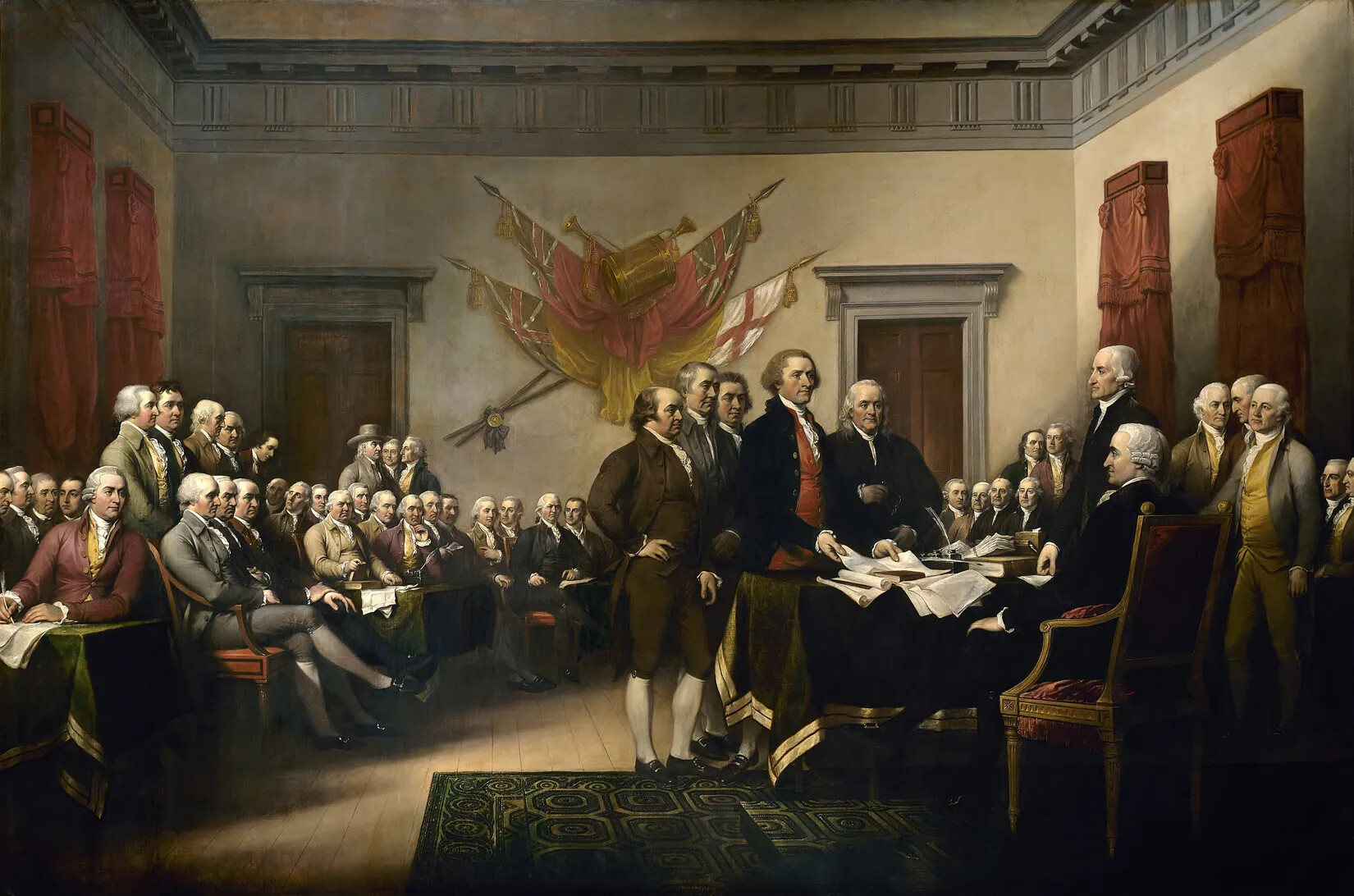
Caption:
This painting shows Thomas Jefferson presenting his draft of the Declaration of Independence to the Continental Congress in Philadelphia on June 28, 1776. Less than a week later, on July 4, the Congress officially voted to accept the document. The patriots had officially declared their independence from Britain. This painting is 12 feet by 18 feet and hangs in the rotunda of the U.S. Capitol in Washington, D.C.Caption:
This painting shows Thomas Jefferson presenting his draft of the Declaration of Independence to the Continental Congress in Philadelphia on June 28, 1776. Less than a week later, on July 4, the Congress officially voted to accept the document. The patriots had officially declared their independence from Britain. This painting is 12 feet by 18 feet and hangs in the rotunda of the U.S. Capitol in Washington, D.C.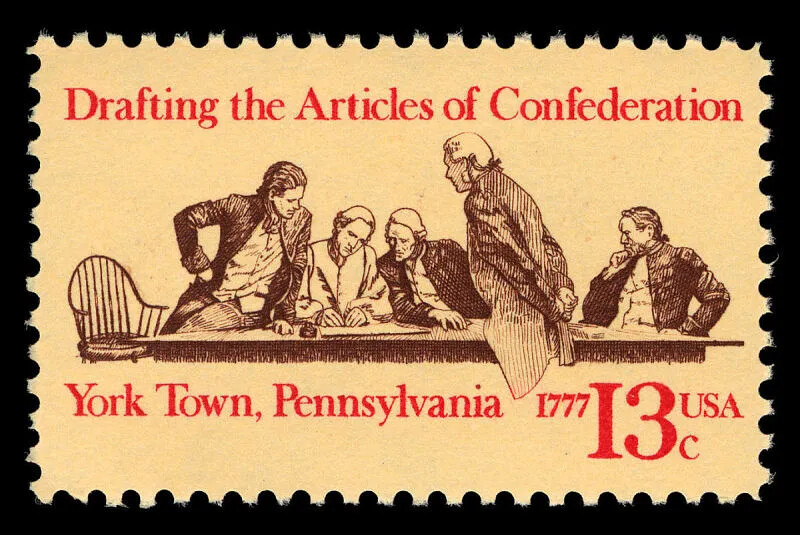
Caption:
The Articles of Confederation was America's first national government. It was a weak national government, because most Americans at that time wanted most government to come from the states. The Articles of Confederation was written in 1777 during the Revolutionary War. At that time, the Continental Congress was meeting in York Town, Pennsylvania. It was ratified in 1781 and replaced by the U.S. Constitution in 1789.What was the first national government in the United States?
Toward the end of the American Revolution, political leaders from all of the states created a national government after writing a document called the Articles of Confederation. Most Americans didn’t want a strong national government. Instead, they wanted most government to come from the states because each state was so different. The Articles of Confederation reflected this idea.
But the government created by the Articles of Confederation was too weak to get anything done. After just a few years, many Americans thought the Articles of Confederation needed to be rewritten so that the government would work better at protecting Americans and promoting their freedom and happiness.
How was the Constitution written?
In 1786, political leaders from all over America got together at a meeting in Annapolis, Maryland, to rewrite the Articles of Confederation. Once the meeting started they decided to get rid of the Articles of Confederation altogether and create an entirely new form of government.
The following summer, the political leaders met again, this time in Philadelphia, to write a new constitution for the United States. This meeting is now called the Constitutional Convention, and the men who attended it are called America’s Founding Fathers.
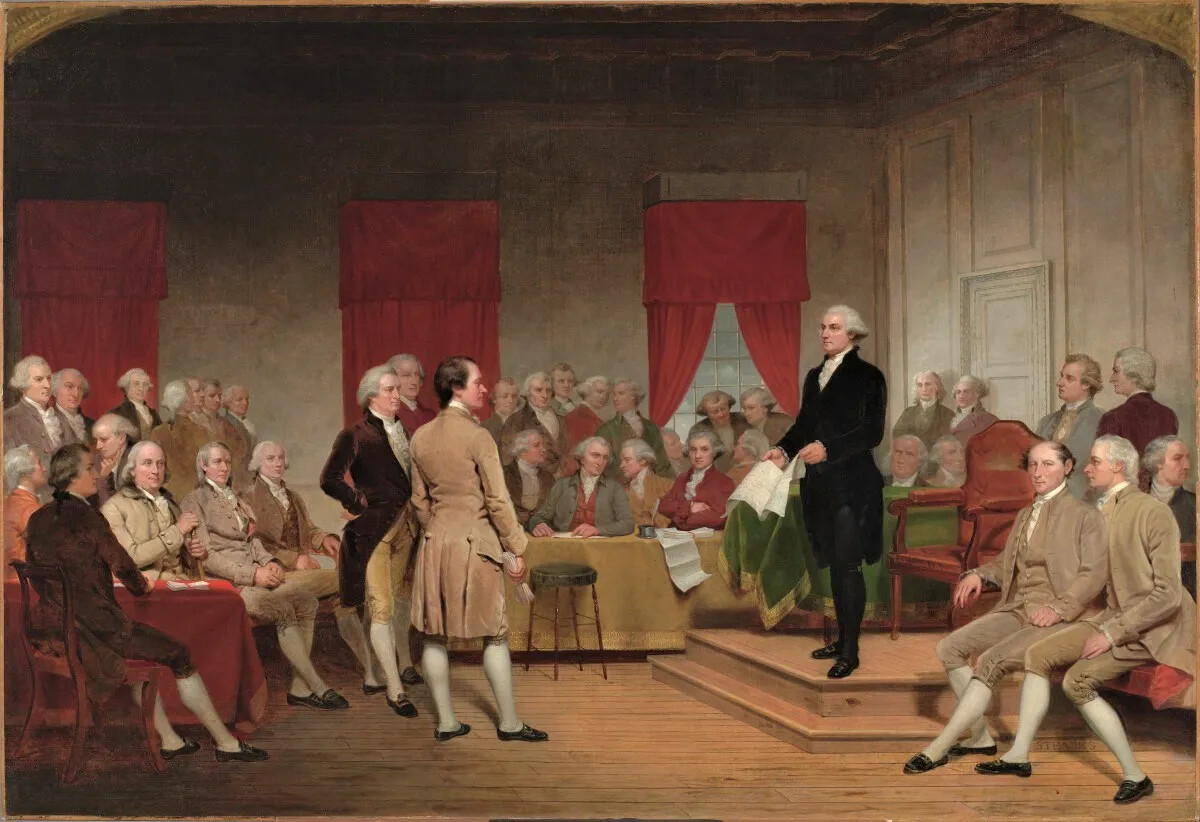
Caption:
In the summer of 1787, political leaders from all over America met in Philadelphia to write a new constitution for the United States. This meeting is now called the Constitutional Convention. George Washington, who had led American troops to victory in the American Revolution, was chosen to be the leader of the convention. He kept the convention running smoothly and calmly. He also convinced everyone at the convention to work together and compromise to write a successful constitution.
Women weren’t allowed to vote in the 1700s or participate in creating the new government. That’s why you don’t hear about the “Founding Mothers.” However, women still had opinions on the Constitution and the way they should be governed. John Adams’ wife Abigail wrote him lots of letters, and in one of those letters she asked him to “remember the ladies” by recognizing women's rights too. But it wasn’t until 1920 that the U.S. Constitution recognized women’s right to vote.
New Hampshire sent two delegates to the Constitutional Convention. They were named John Langdon and Nicholas Gilman. They were late getting to the Constitutional Convention, though. In fact, the members of the Constitutional Convention thought about sending a message to New Hampshire, asking where the state’s delegates were.
But even though the New Hampshire government picked delegates, it didn’t want to pay for any of the costs for them to attend, like travel expenses or a place to stay while the delegates were in Philadelphia. Finally, John Langdon agreed to pay all the expenses for him and Nicolas Gilman to attend. The convention started in May, but they didn’t get there until July for the last two months of the convention’s meetings.
Caption:
John Langdon was an American Founding Father and an important political leader from New Hampshire. He was an early supporter of independence from Great Britain. He served in the Continental Congress and led troops at an important American victory, the Battle of Saratoga. After the American Revolution, he was the second person to be elected governor of New Hampshire , which was then called “president.” Langdon was one of New Hampshire’s delegates to the Constitutional Convention in 1787. He supported a strong central government and campaigned in favor of ratification in New Hampshire. His efforts helped New Hampshire become the ninth and deciding state to ratify the U.S. Constitution. He was one of New Hampshire’s first U.S. senators, serving from 1789 to 1801. Later he was elected to the New Hampshire House of Representatives and again as New Hampshire’s governor.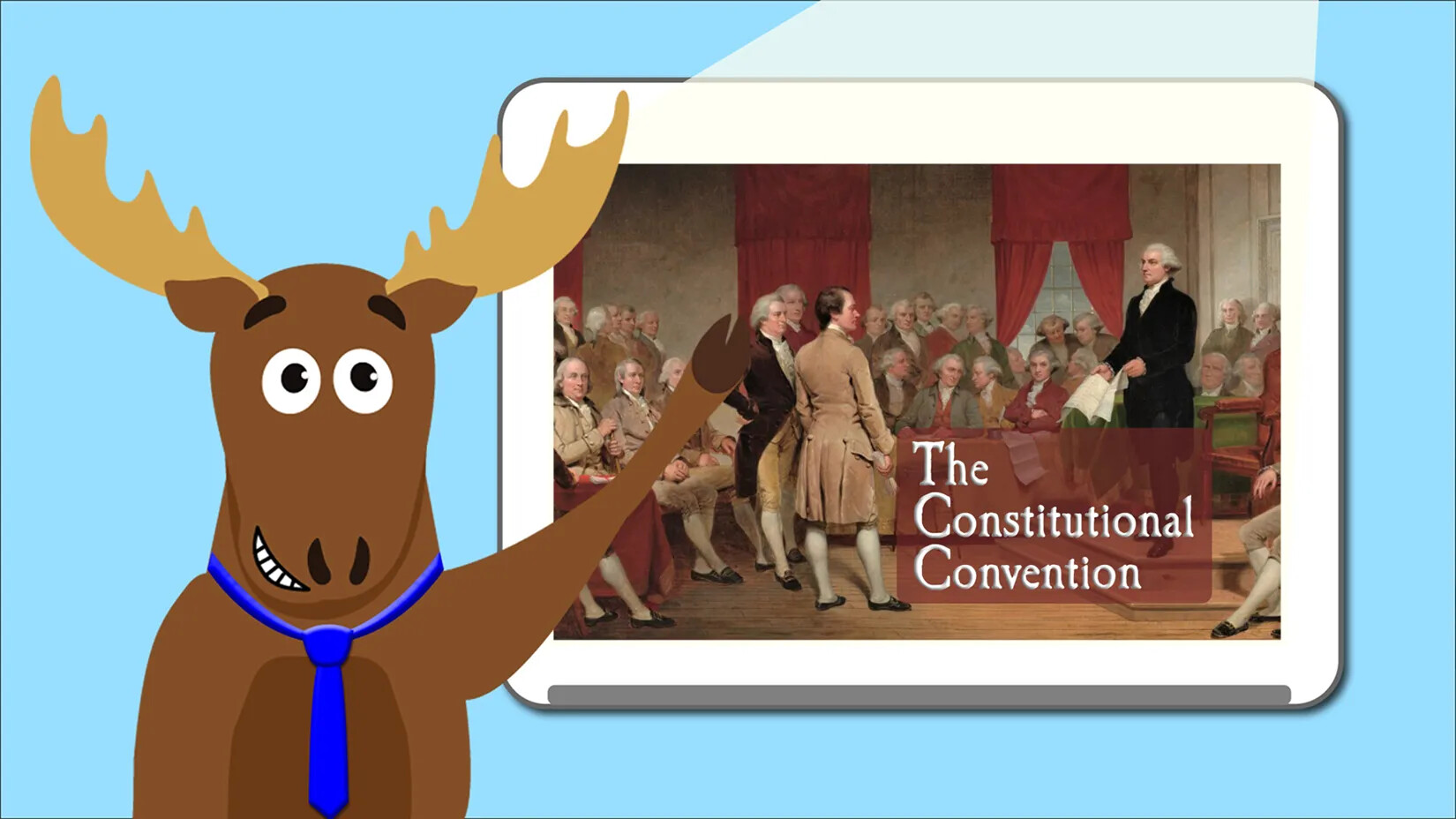
Mason Explains: The Constitutional Convention
Writing the U.S. Constitution!
Let's Review!
What are the big ideas in this section?
A National Government
The 13 states needed a national government after they won the Revolutionary War. A national government would make decisions that affected all the states, like how America got along with other countries, and would help settle arguments between the states.
Fundamental Ideas
The new government would be based on the same foundational ideas that formed the state governments. It would also support the principles in the Declaration of Independence.
Articles of Confederation
The first national government of the United States was called the Articles of Confederation. It failed because it made the state governments too strong and the national government too weak.
Constitutional Convention
In 1786 and 1787, political leaders from all over the country got together to fix the government. They first decided to get rid of the Articles of Confederation and then, the next summer, to write a new constitution.
The U.S. Constitution
What form of government did the U.S. Constitution create?
The U.S. Constitution is based on the same foundational principles that were the basis of the state governments. The document is also organized like many of the state constitutions are. It begins with a preamble that explains why Americans created a national government and what they hoped the national government could help them do as a country.
Mason Explains: The Preamble
We the People!
The rest of the Constitution is divided into seven sections, which are called articles. The first three articles explain the three branches of the national government because the U.S. government is divided into three parts, just like New Hampshire’s state government.
- Legislative Branch: Congress, which is split between two houses, the U.S. House of Representatives and the U.S. Senate (Article 1)
- Executive Branch: the president (Article 2)
- Judicial Branch: the court system (Article 3)
Just like in state governments, each branch of the U.S. government has specific powers that the other branches don’t have. Also, each branch can check the other branches, which keeps any one branch from becoming too powerful. This idea is called checks and balances. The most common check is that many of the people who hold offices in the U.S. government are elected by the people and can be voted out of office if the people don’t like the job they do. All three branches work for the common good of the American people.
More information about the division of power between these three branches of government and the way each branch works is in Unit 18: Civics and Government Today.
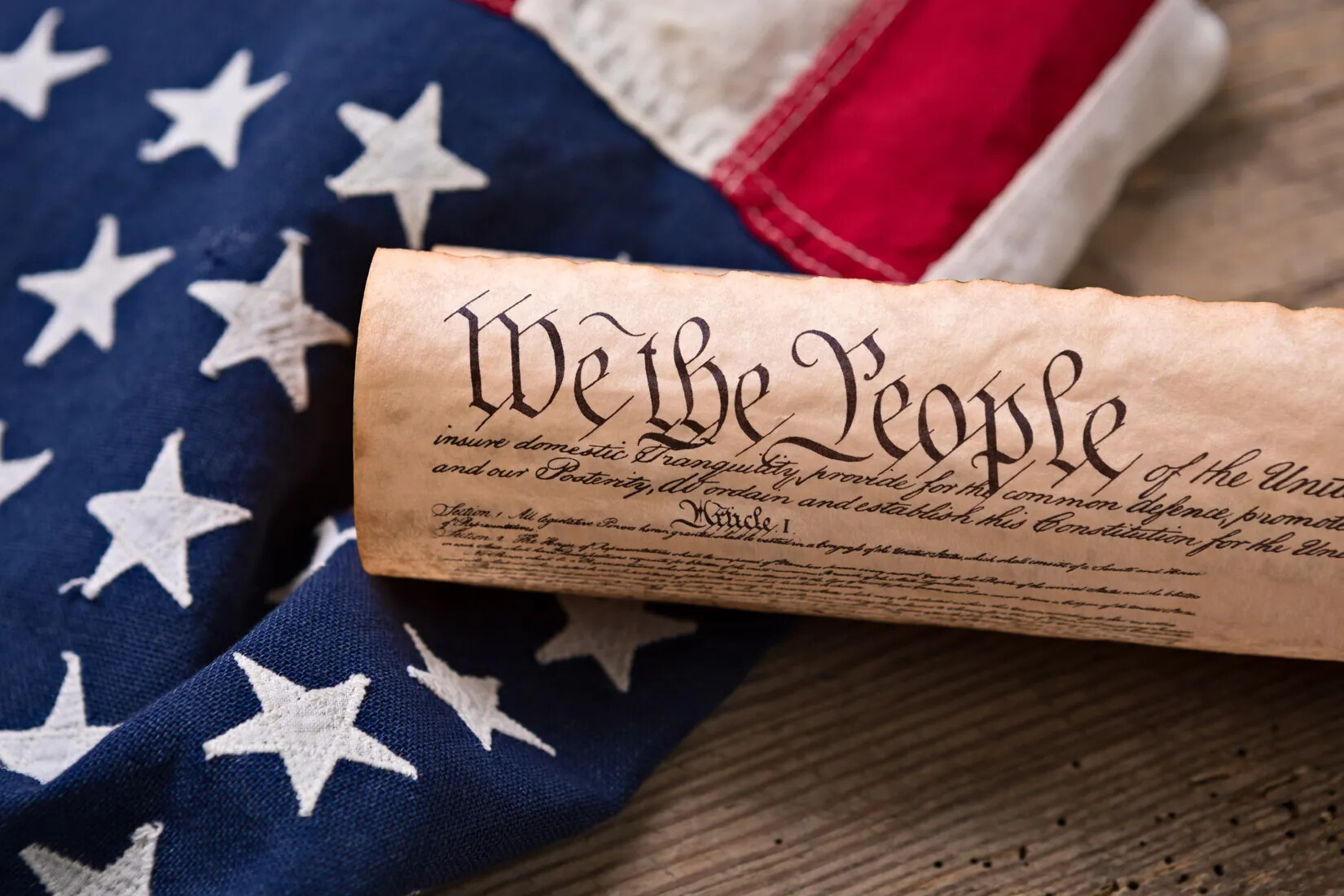
Caption:
The U.S. Constitution is based on the same foundational principles as the state governments. It begins with a preamble that explains why Americans created a national government and what they hoped the national government could help them do as a country. It then has seven articles, the first of which explain how the government should function and what kinds of powers the national government should have. The other articles say what the relationship between the national government and state governments should be, and how the Constitution could be changed.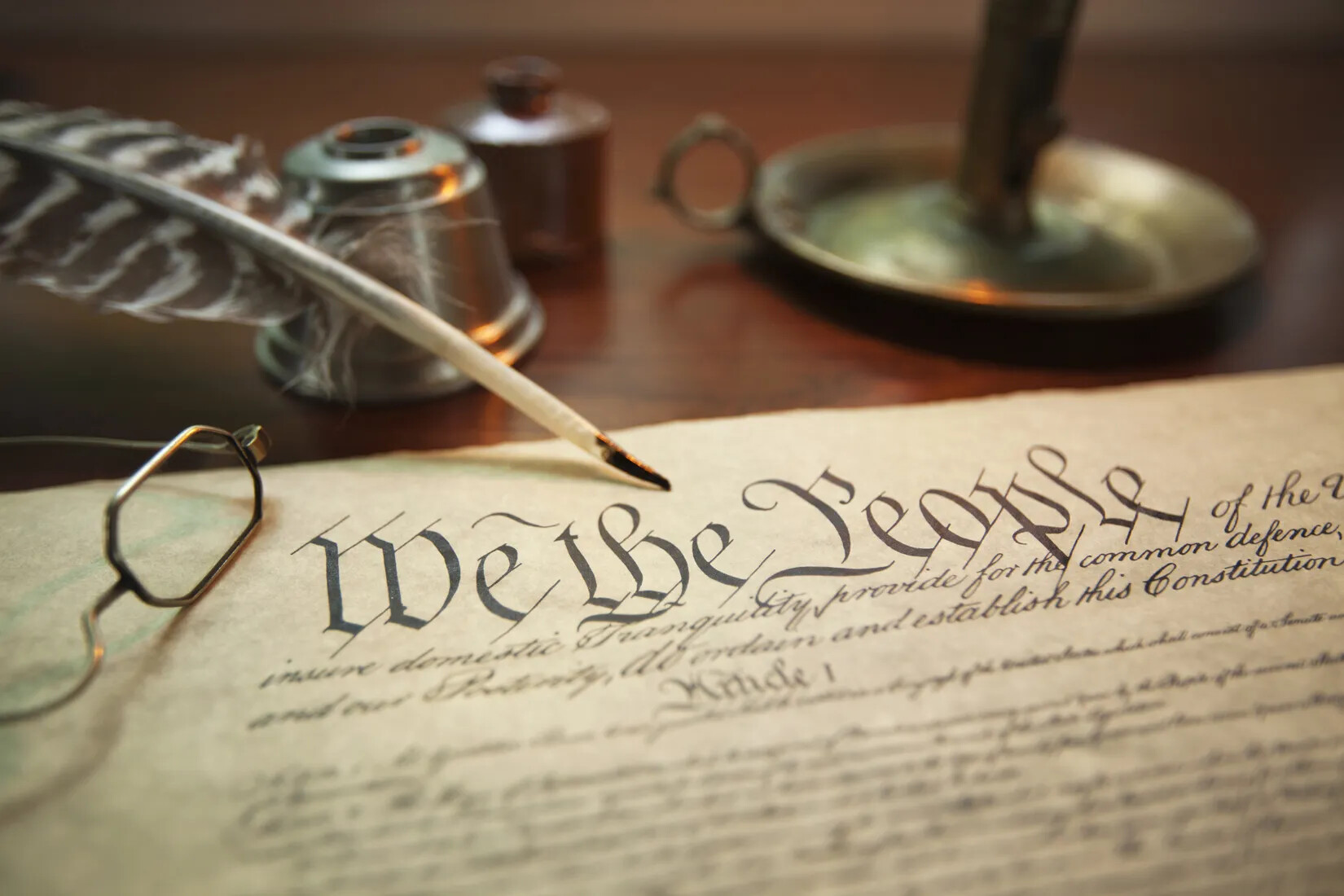
Caption:
The U.S. Constitution is based on the same foundational principles as the state governments. It begins with a preamble that explains why Americans created a national government and what they hoped the national government could help them do as a country. It then has seven articles, the first of which explain how the government should function and what kinds of powers the national government should have. The other articles say what the relationship between the national government and state governments should be, and how the Constitution could be changed.The other four articles of the U.S. Constitution discuss the relationship between the states and the federal government, the requirements for the Constitution’s ratification, and ways to change the U.S. Constitution, which is called amending the Constitution.
The U.S. Constitution that the Founding Fathers wrote in 1787 did not include a bill of rights, which is a list of the people’s rights. In fact, it didn’t even mention people’s rights. This issue would come up when it came time for the people to adopt the U.S. Constitution.
Did everyone agree on the form of government the U.S. Constitution created?
The Founding Fathers agreed on a lot when it came to writing the U.S. Constitution, especially the foundational principles of government. But there were also some pretty big issues that they didn’t agree on. They had to work out compromises on these issues if they were going to create a government for everyone.
Let’s look at some of those issues to see how the delegates worked together to find a compromise that everyone could live with.
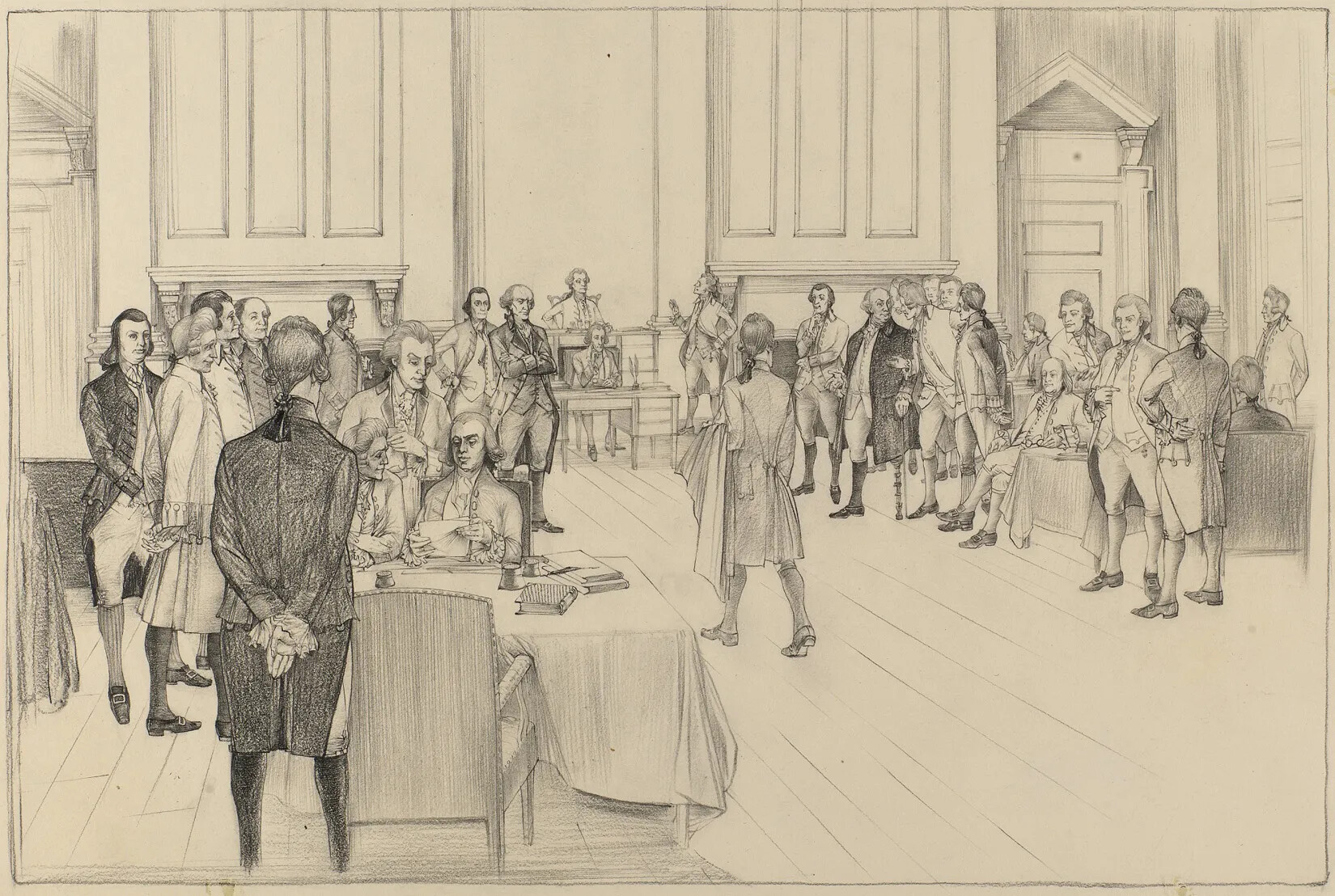
Caption:
In the summer of 1787, political leaders from all over America met in Philadelphia to write a new constitution for the United States. This meeting is now called the Constitutional Convention.The Great Compromise
One of the most important questions the delegates had to settle was how to organize the representatives in the legislative branch, which is the U.S. Congress. Should each state get one vote in the legislature? Or should the states with more people living in them have more voting power?
The New Jersey Plan: The delegates from New Jersey came up with a plan that would give every state the same number of representatives in the legislature. The smaller states liked this plan because it meant that the small states—where fewer people lived—would have just as much power in Congress as the big states—where many people lived. But to the big states, this plan didn’t seem fair.
The Virginia Plan: The delegates from Virginia came up with another plan that would base the number of representatives each state got in the legislature on the state’s population. So the big states would elect more representatives than the small states. This plan would give more power to representatives from the places where more people lived.
The small states didn’t like the Virginia Plan. They argued that if the big states had more representatives in the legislature than the small states, the small states would always lose out to the big states. The big states would be able to ignore the small states and do whatever they wanted because they had so many representatives. To the small states, that plan didn’t seem fair.
The Connecticut Compromise: The delegates from Connecticut suggested a compromise. Their idea was to adopt the Virginia Plan for the U.S. House of Representatives and the New Jersey Plan for the U.S. Senate.
So the number of representatives each state gets in the House of Representatives is based on how many people live in that state. The big states—like Virginia, New York, and Pennsylvania—have more representatives than the small states—like New Hampshire, New Jersey, and Delaware.
But the U.S. Senate is different. In the Senate, each state has two senators, no matter how big or small the state is.
Through this compromise, each state got some—but not all—of what it wanted, and the effort to create a new government could move forward. It is compromises like this one that allows the government to function in a country that has so many people, who all have different views and opinions.
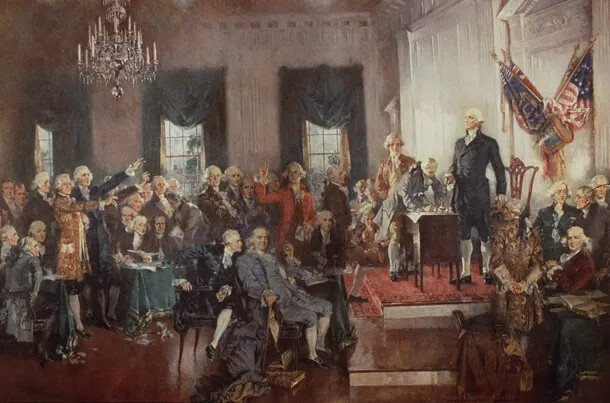
Caption:
In the summer of 1787, political leaders from all over America met in Philadelphia to write a new constitution for the United States. This meeting is now called the Constitutional Convention. In this painting, which is displayed in the U.S. Capitol in Washington, D.C., George Washington is shown on the right side, standing on the stage. Washington had been elected the leader of the convention.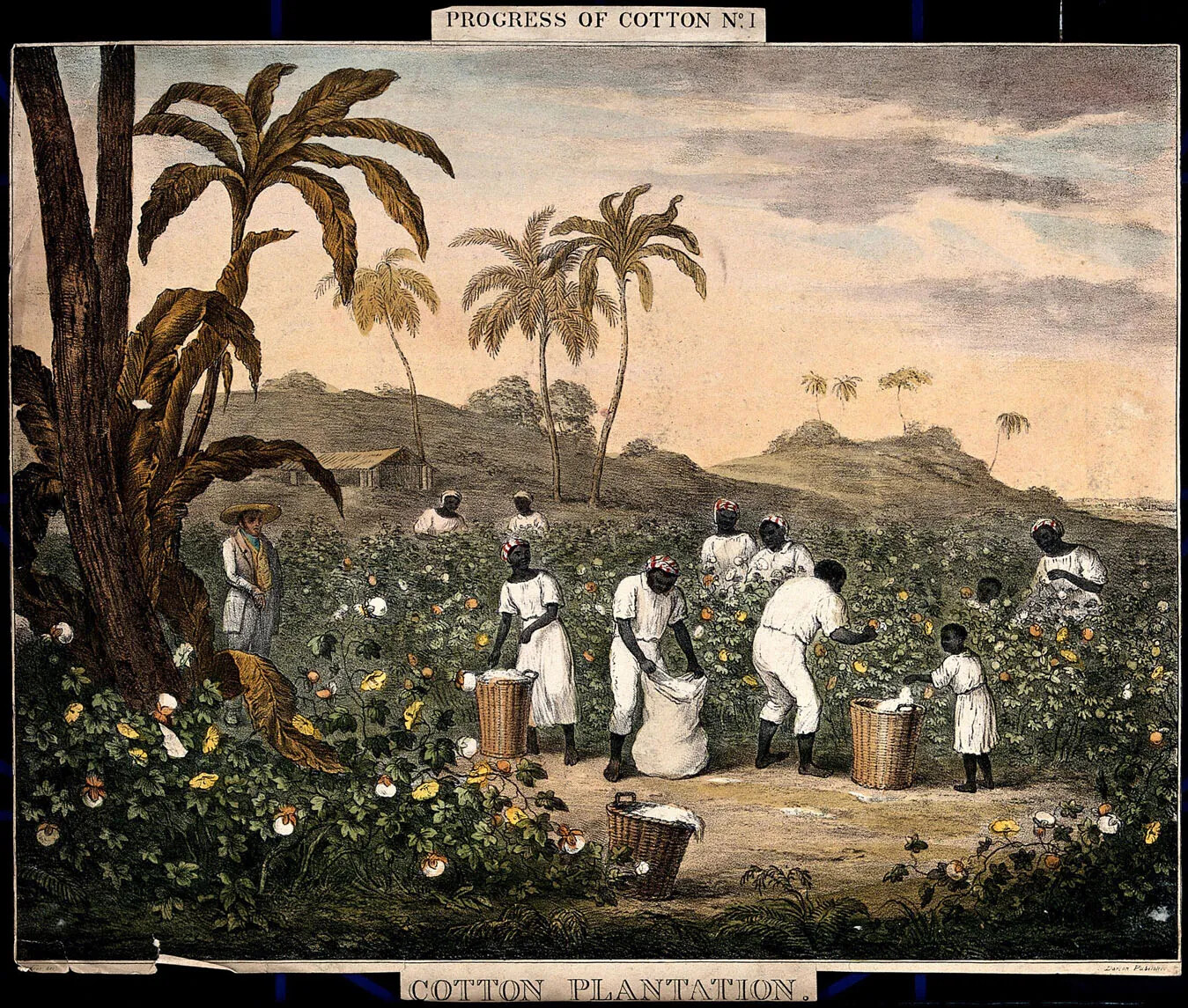
Caption:
Slavery was a labor system in America where Black people were taken from Africa to this country and forced to work for whites. Enslaved people had no freedom and could not leave. When they had children, the children were enslaved too. This image shows plantation slavery, where enslaved people had to work in the fields to plant and harvest a cash crop, like cotton. Slavery in the United States was not outlawed until 1865, after the Civil War, when the 13th Amendment to the U.S. Constitution was ratified.Slavery
The other big compromise at the Constitutional Convention was about slavery. Slavery was a labor system in America. Black people were taken from Africa and brought to this country where they were forced to work for white people. Enslaved people had no freedom and could not leave. When they had children, their children were enslaved too.
Although slavery existed throughout the original 13 colonies, many of the colonies in the northern part of America ended slavery after the American Revolution. Enslaved people who lived in these states were freed over time. In the southern part of America, slavery expanded after the American Revolution.
During the Constitutional Convention, delegates from the southern states wanted the Constitution to protect slavery, but many delegates from the northern states wanted to end slavery, or at least limit it. In the end, the Constitution did provide some protection for slavery but not as much protection as the southerners wanted. It was a compromise that allowed the work on the Constitution to go forward, but not very many people were happy about it.
Adopting the Constitution
How was the U.S. Constitution adopted?
After the delegates at the Constitutional Convention finished writing the U.S. Constitution, they sent it to the states so the states could adopt it, which is called ratification. In order for the Constitution to be ratified, 9 of the 13 states had to vote to approve it.
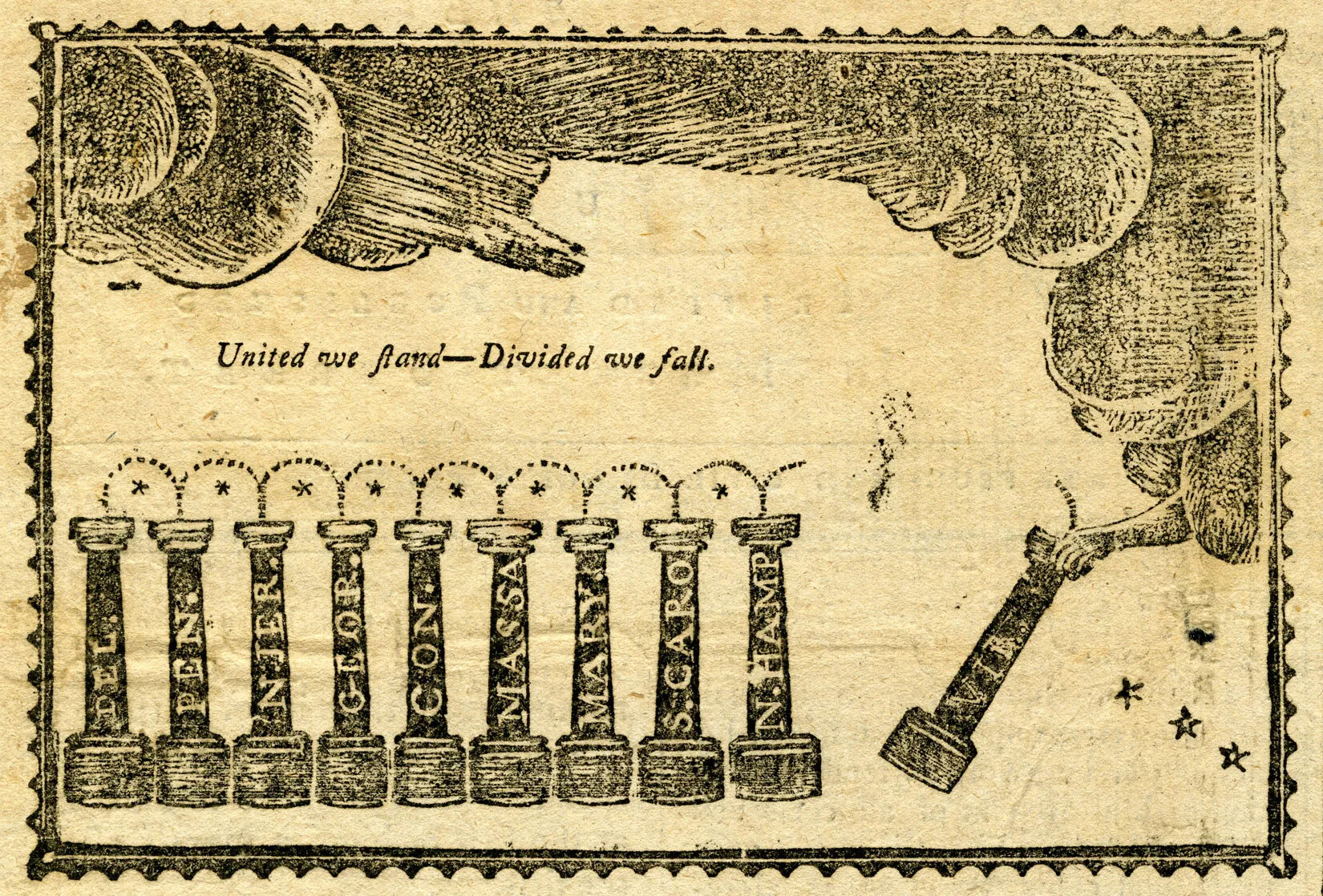
Caption:
This illustration appeared in newspapers all over the United States in June 1788, showing how New Hampshire was the ninth state to ratify the Constitution. After New Hampshire's vote, the Constitution could become the law of the land.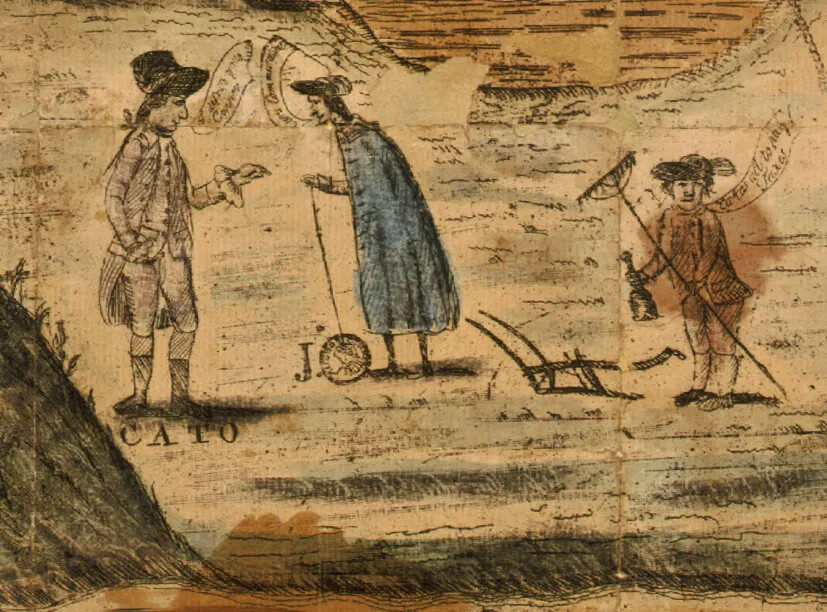
Caption:
In 1787, not all Americans liked the new U.S. Constitution. The process of ratification was divisive, and people for the Constitution and against the Constitution argued with one another. The artist who drew this political cartoon supported ratification. The caption at the bottom of the cartoon read, "a house divided against itself cannot stand." This means that the artist believed the only way to preserve the United States was by ratifying the Constitution.
Newspapers all over the country published articles and letters from people who either supported the Constitution or were against it. In New York, the newspapers were filled with arguments for or against the Constitution. Three men—Alexander Hamilton, James Madison, and John Jay—published a series of 85 articles in New York newspapers that laid out why Americans should support the Constitution. The articles were long and explained how the three men thought the new government would work to support everyone while still protecting their rights and freedoms. After the Constitution was ratified, the essays were gathered together and published as the best explanation of the American system of government. They are called the Federalist Papers and are an important example of persuasive writing.
Not all Americans liked the new U.S. Constitution, though. Many of them thought the Constitution made the national government too powerful. Even more people were unhappy that the Constitution didn’t include a bill of rights that listed the rights guaranteed to the people, like state constitutions did.
The political leaders who supported the Constitution promised Americans that they would adopt a bill of rights after the Constitution was approved.
Eventually, after lots of debate, enough Americans supported the Constitution that states started to ratify it.
New Hampshire voted to ratify the U.S. Constitution on June 17, 1788. It was the ninth state to ratify it, which was a very important number. Once nine states had adopted it, the Constitution would become the official law of the land, and the government created by the Constitution would go into effect, even in states that hadn’t ratified the Constitution yet. So New Hampshire’s vote to ratify it was an important moment in American history.
The new American government was scheduled to start operating on March 4, 1789, after elections were held in each state to find out who would represent the people in this new democracy .
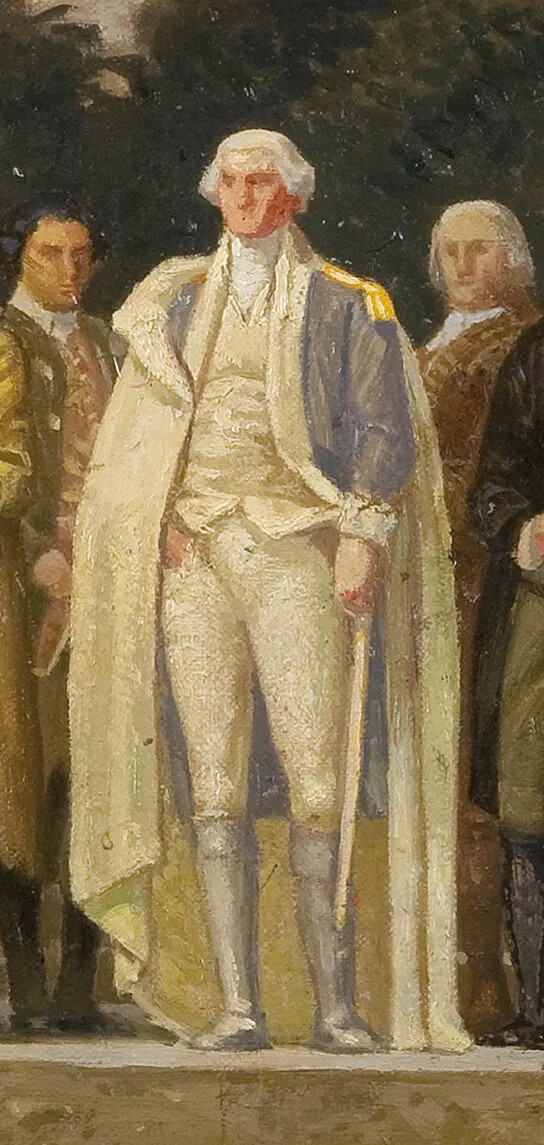
Caption:
In the summer of 1787, political leaders from all over America met in Philadelphia to write a new constitution for the United States. This meeting is now called the Constitutional Convention. George Washington, who had led American troops to victory in the American Revolution, was chosen to be the leader of the convention. He kept the convention running smoothly and calmly. He also convinced everyone at the convention to work together and compromise to write a successful constitution.Caption:
When the 13 American colonies declared themselves independent from Britain, they had to form a government for their new country. They had to decide how political power was going to be shared between the states and the federal government and develop a process for passing laws that would govern the new country. At first they wrote a document called the Articles of Confederation, but the Articles didn’t work very well and they set them aside. Next they wrote a document called the Constitution. For the Constitution to go into effect, 9 of the 13 states had to agree to it, which is called ratifying. In June 1788, New Hampshire ratified the new Constitution and was the 9th state to do so. Even though other states ratified the Constitution too, New Hampshire’s vote meant the new Constitution could go into effect.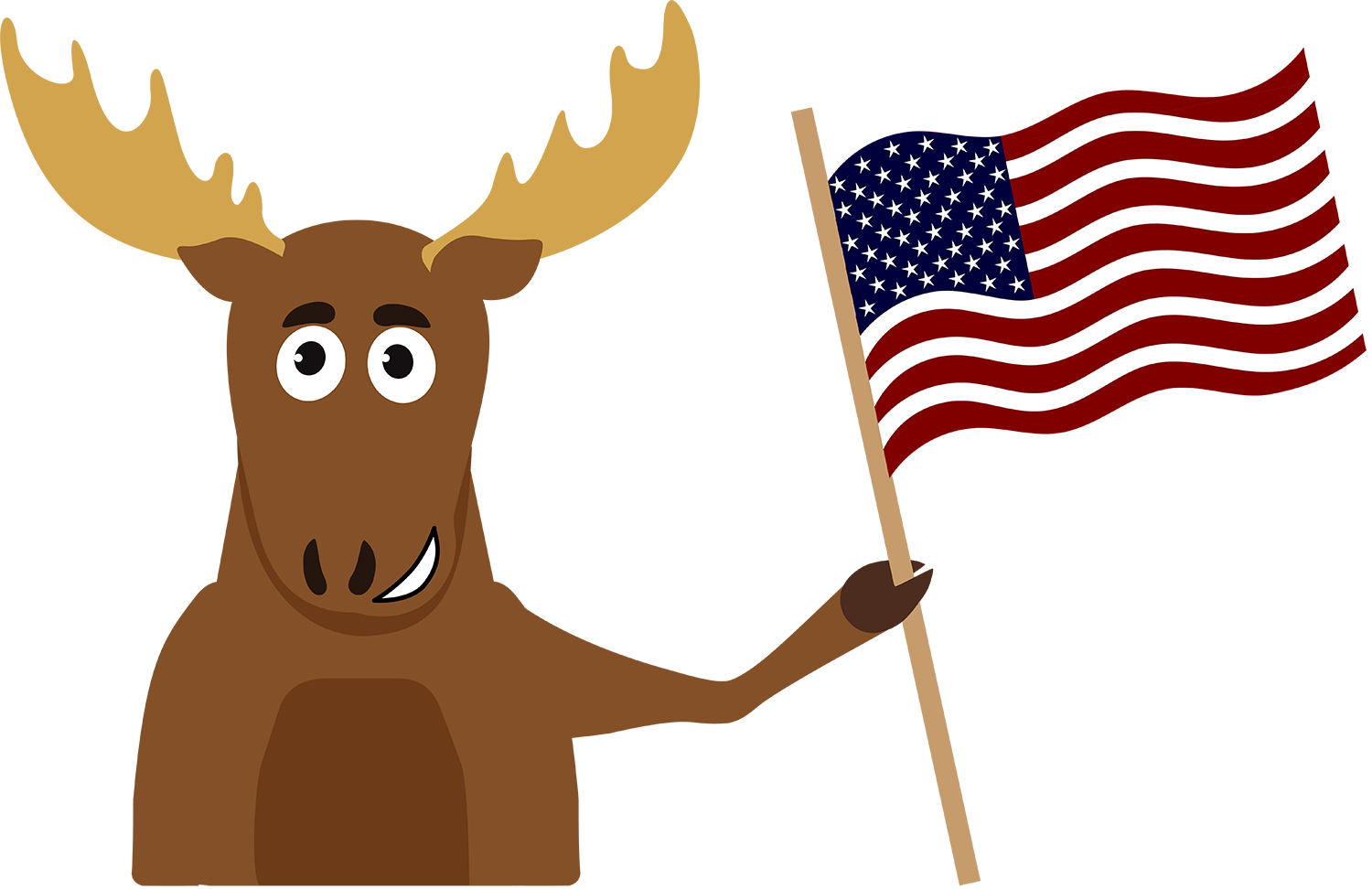
America’s first president under the new U.S. government was George Washington. He served two terms in office as president. George Washington is the only American president who was not a member of a political party. In fact, he didn’t like the way Americans seemed to be dividing into two groups. If he had had his way, there would be no political parties in the United States at all. For George Washington, it was all about bringing the country together. To promote Americans’ feelings of patriotism, George Washington toured throughout the country during his presidency. His New England tour was in the fall of 1789, when he visited Portsmouth and the seacoast region of New Hampshire.
Let's Review!
What are the big ideas in this section?
Structure
The U.S. Constitution is based on the same fundamental ideas as the state governments. It has a preamble and seven articles that organize the structure of the government.
Articles
The first three articles of the Constitution create the legislative, executive, and judicial branches. Each has specific powers and the power to check the other branches to keep the government power balanced. The next four articles are about how the state governments and the federal government work together, how to change the Constitution, and what the states need to do to adopt it and make it law.
Debates
There were many topics of debate during the writing of the Constitution. One was about how to fairly represent both large and small states, which was solved with a bicameral legislature. Representation in the House of Representatives was based on population and the Senate was divided equally between the states. Another debate was about continuing the practice of enslaving people in the United States. Leaders agreed to limit the practice of slavery but not end it.
Ratification
In order to make the Constitution law, 9 of 13 states had to ratify it. Some did, but many Americans were concerned that the Constitution did not have a Bill of Rights. Leaders promised to add one, and the Constitution was ratified on June 21, 1788. The new American government went into effect on March 4, 1789.
The Bill of Rights
What is the Bill of Rights, and how does it protect our rights?
When the U.S. Constitution was written, many Americans were worried that some of their most important rights, such as freedom of speech, were not listed in the document. In 1791, two years after the Constitution went into effect, Americans amended the Constitution by adding a list of rights that they believed were the most important for their liberty and freedom. This list, which contains 10 amendments to the Constitution, became known as the Bill of Rights.
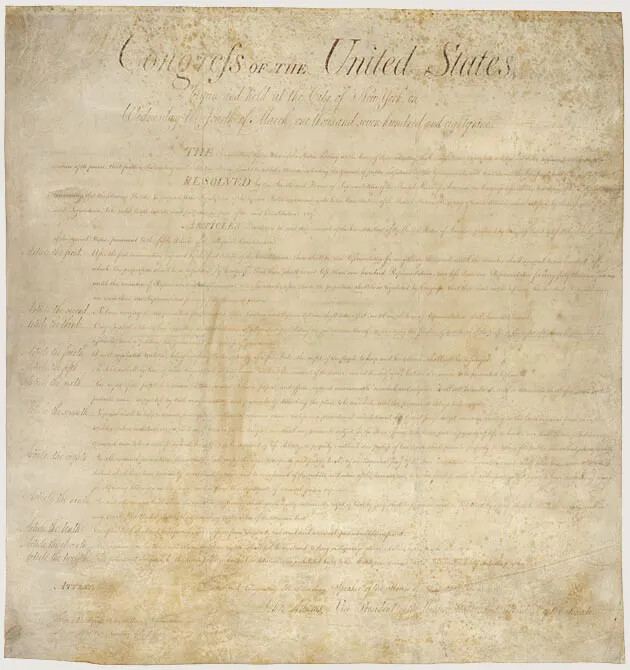
Caption:
When the U.S. Constitution was written, many Americans were worried that some of their most important rights, such as freedom of speech, were not listed in the document. In 1791, two years after the Constitution went into effect, Americans amended the Constitution by adding a list of rights that they believed were the most important for their liberty and freedom. This list, which contains 10 amendments to the Constitution, became known as the Bill of Rights.
Since 1791, many more amendments have been made to the Constitution. Some of the amendments are changes to the way government is organized, and some of the amendments expand the rights guaranteed to Americans. There are now 27 amendments to the U.S. Constitution, and even more are being considered.
Although all of the amendments are important to Americans, the freedoms listed in the First Amendment are the most valued by many people. These rights include:
- freedom of speech
- freedom of assembly
- freedom of petition
- freedom of religion
- freedom of the press
By having these freedoms, Americans protect their right to speak out against the government if they disagree with what the government does. As long as we have these rights, we can speak up for all of our rights. That’s why the First Amendment is first—it’s the most important one!
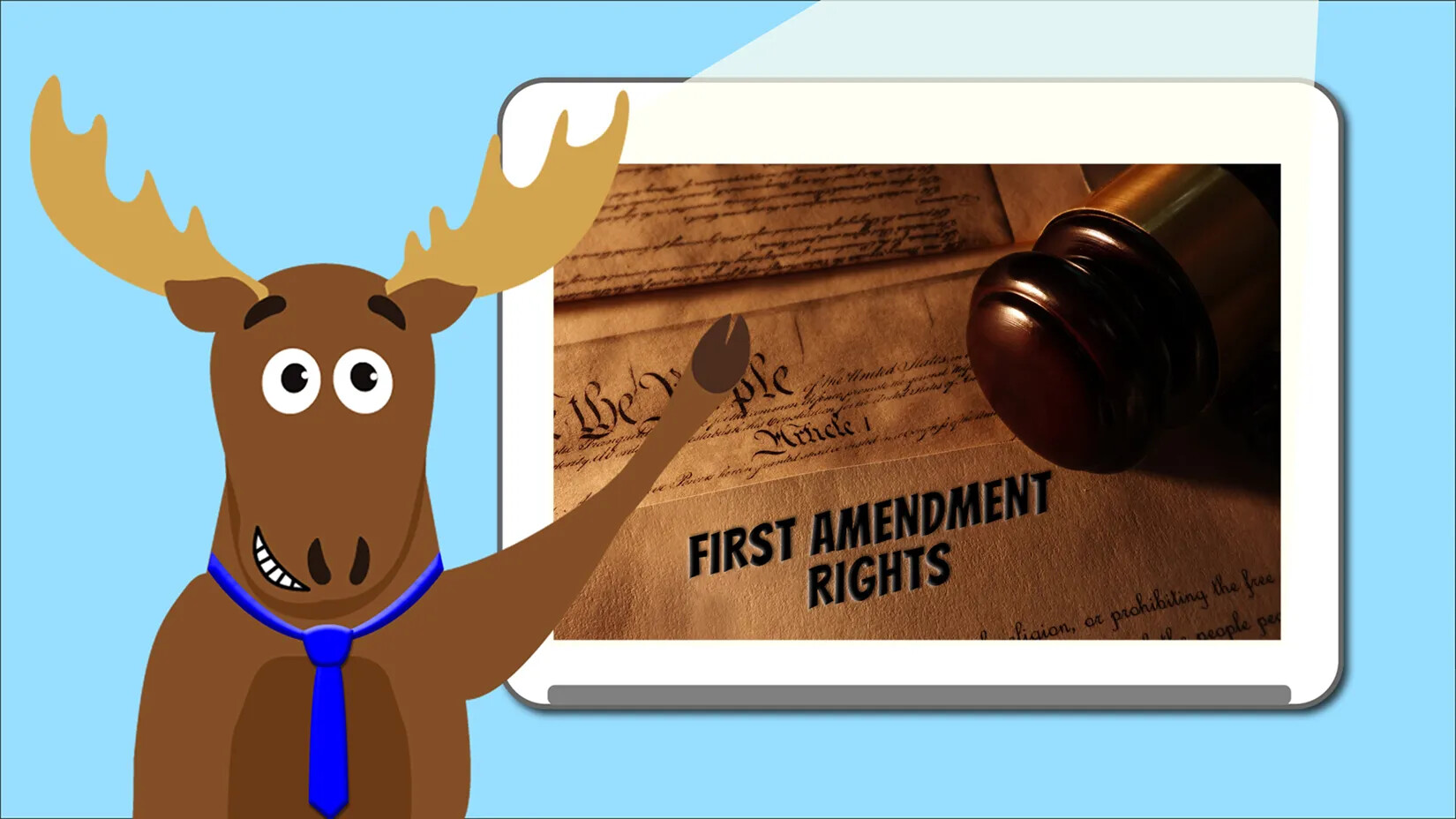
Mason Explains: First Amendment Rights
The First is First!
Let's Review!
What are the big ideas in this section?
What's Missing?
The U.S. Constitution did not originally include a Bill of Rights when it was written. This worried many Americans because they did not see that their freedoms were protected.
The Bill of Rights
The Bill of Rights is the first 10 amendments to the Constitution. These amendments were added in 1791. They protect the rights of the people against the power of the government.
Amending the Constitution
Two years after the Constitution became law, it was amended. A list of rights that Americans believed were the most important for their liberty and freedom were added.
The First Amendment
The freedoms in the First Amendment are among the most valued by many people. They include the freedom of speech, freedom of assembly, freedom of petition, freedom of religion, and freedom of the press.
Conclusion
Ratifying the Constitution and passing the Bill of Rights were the final steps in creating the new nation of the United States. The 13 original states had come together in a long process of compromise to create a new system of government that tried to balance order and liberty. This was a big change from the way nations had been governed in the past and in other countries.
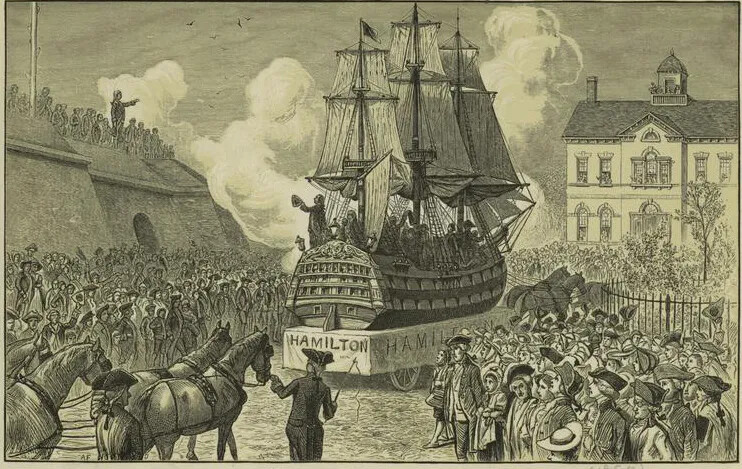
Caption:
This illustration shows a big parade held in New York City to celebrate the ratification of the U.S. Constitution. The ship is called "Hamilton" after Alexander Hamilton, a founding father who attended the Constitutional Convention as a delegate from New York and helped persuade people to support the Constitution.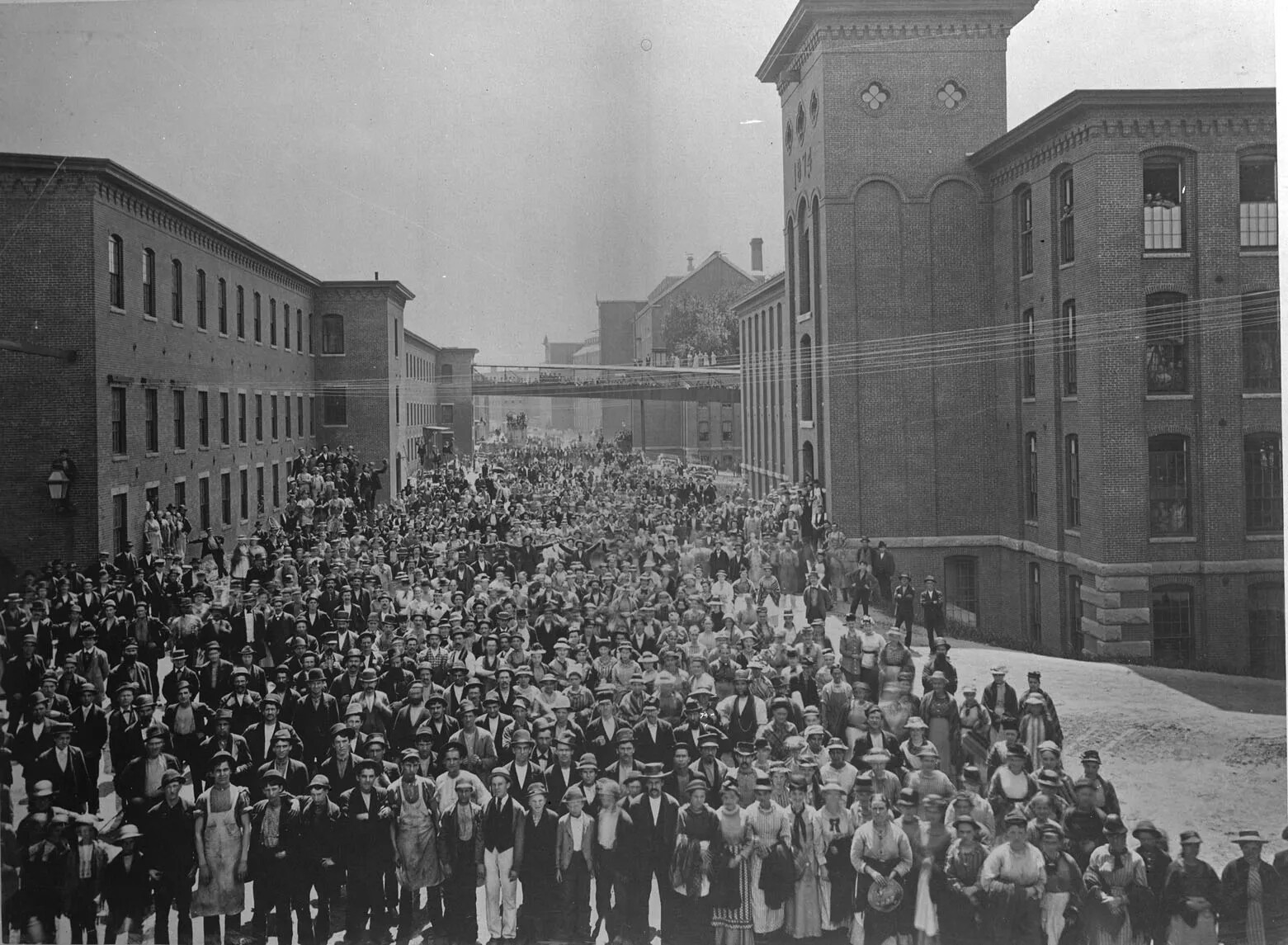
Caption:
The Amoskeag Manufacturing Company was a huge textile company. In the 1910s, it was the largest textile company in the world! This photo shows just some of the workers in the millyard.There were other big changes coming up. While the Founding Fathers were busy building a government, ordinary people were busy building their communities and providing for basic needs. Just like there were big changes in our government, there were big changes to come in the way people lived and worked. At the beginning of the 1800s, most people in New Hampshire were farmers and lived in small towns. By the end of the 1800s, most people worked in factories and lived in cities with thousands of other people.
Unit 6 Student Reading
A printable version of the student reading for this unit, without pictures or graphics.
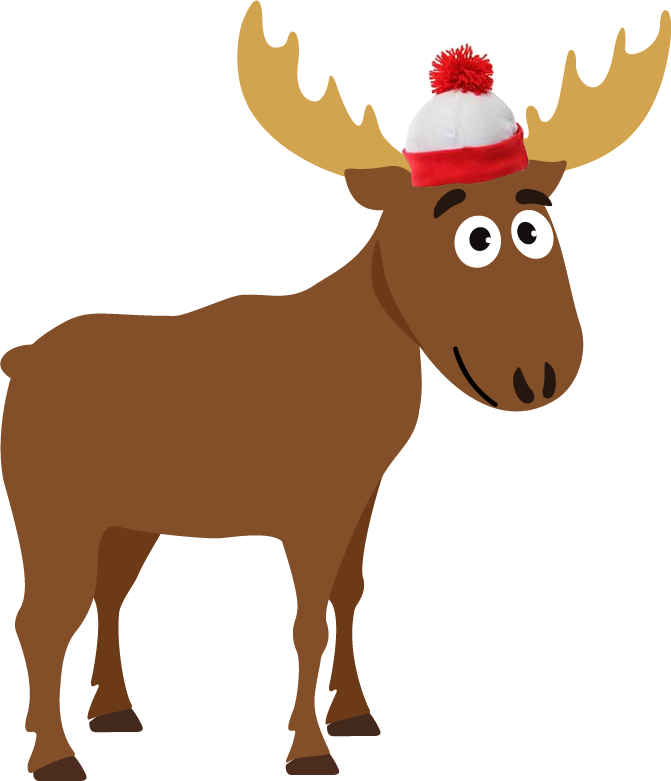

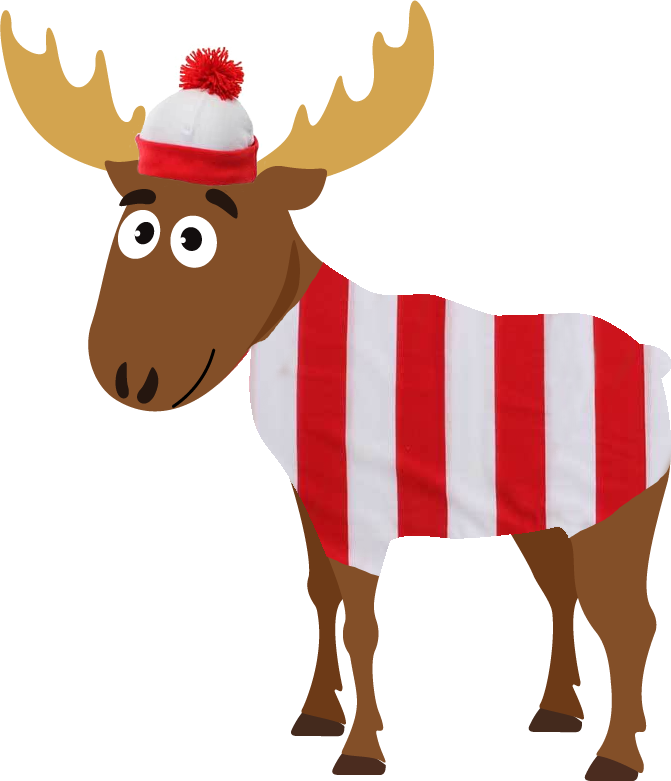


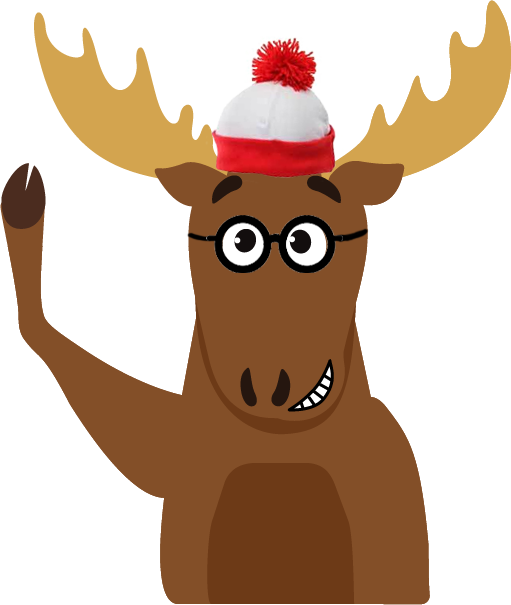
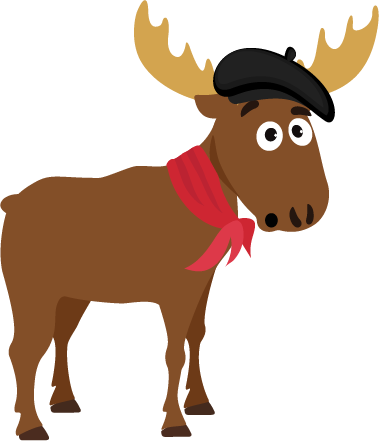
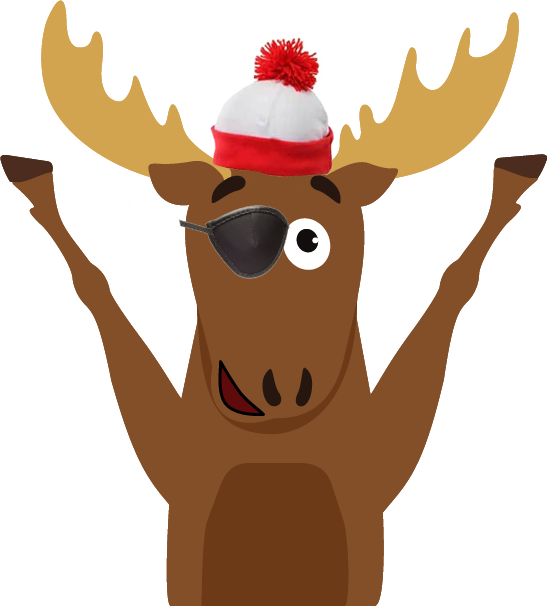








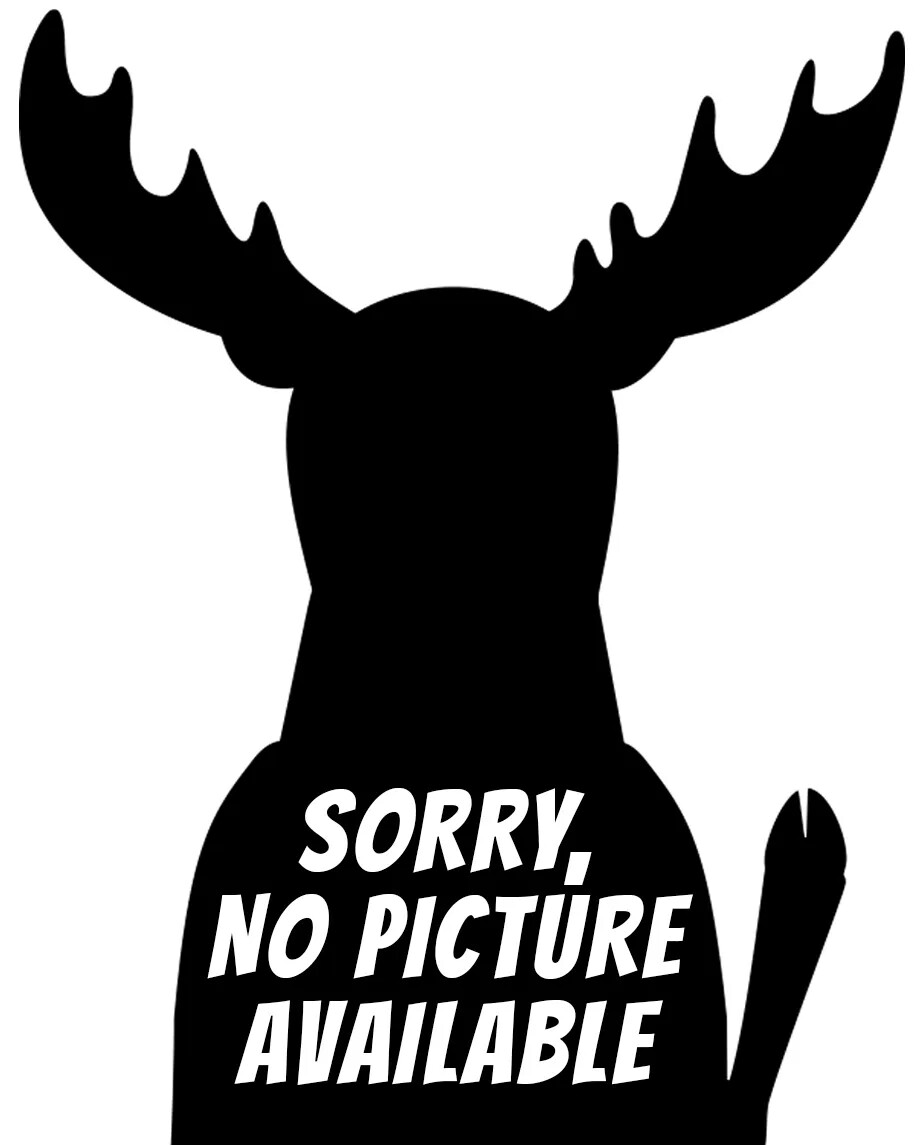

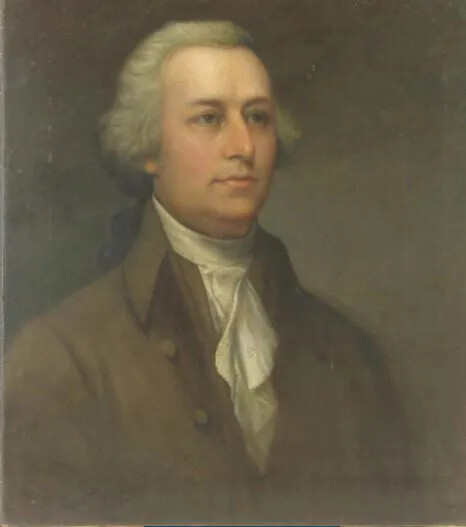
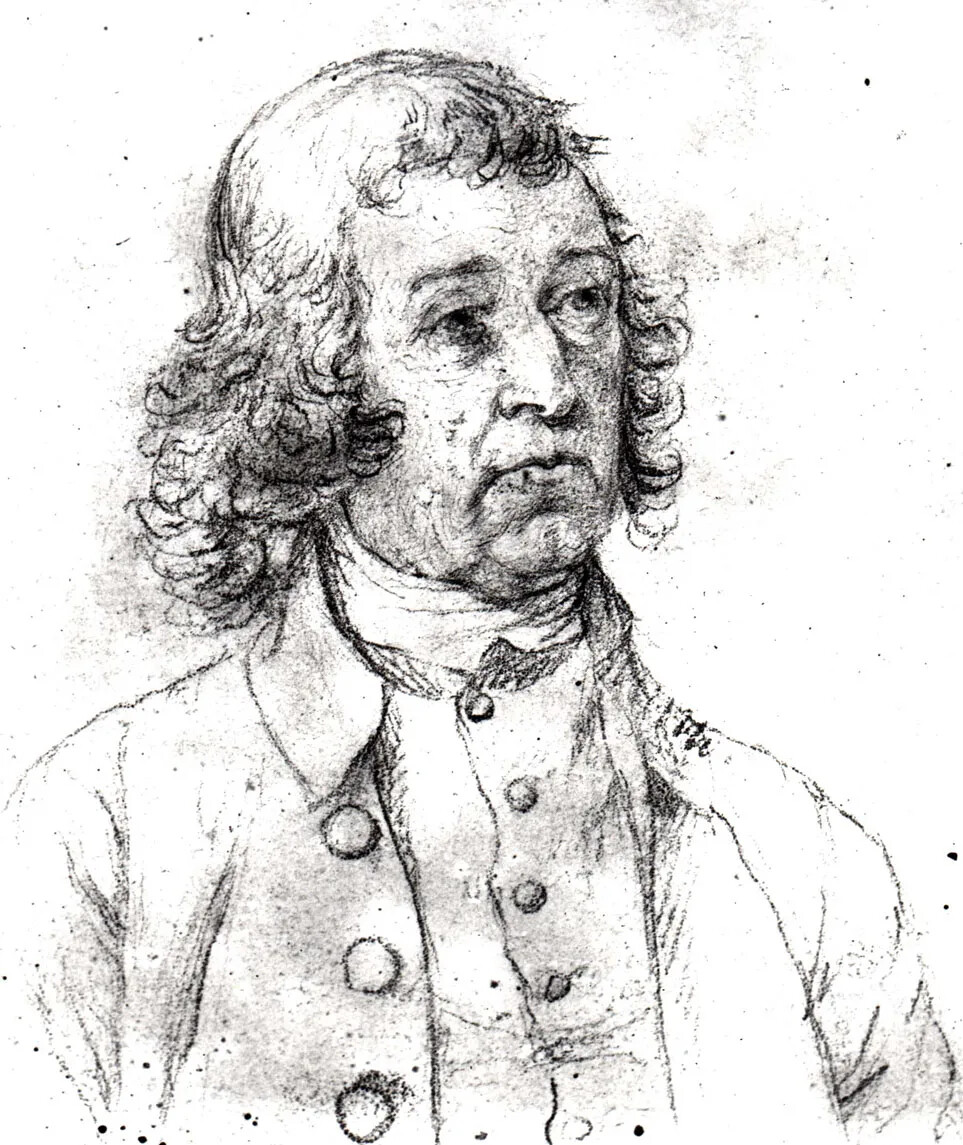
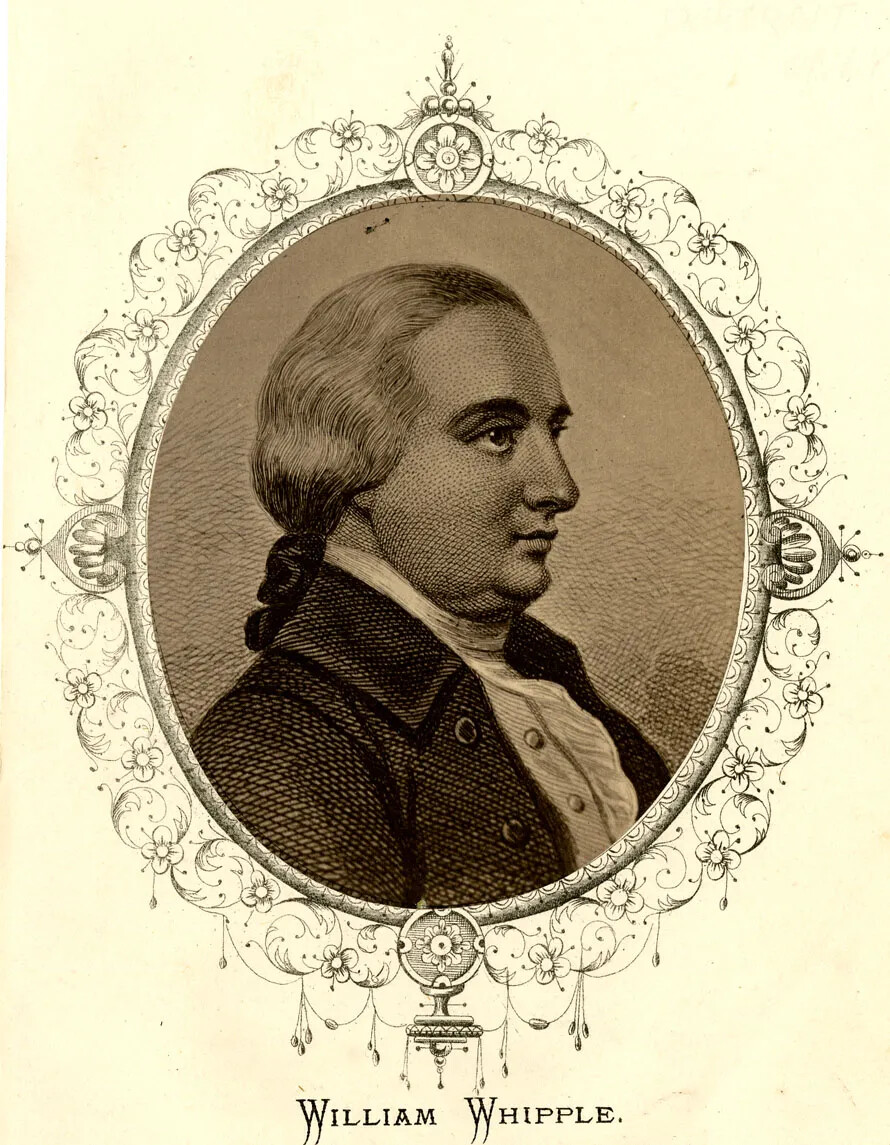


social contract
noun
An agreement between people and their government to give up some rights in exchange for security and law and order